
Shapero Rare Books 50 Fine Books Autumn 2015 50 Fine Books Autumn 2015


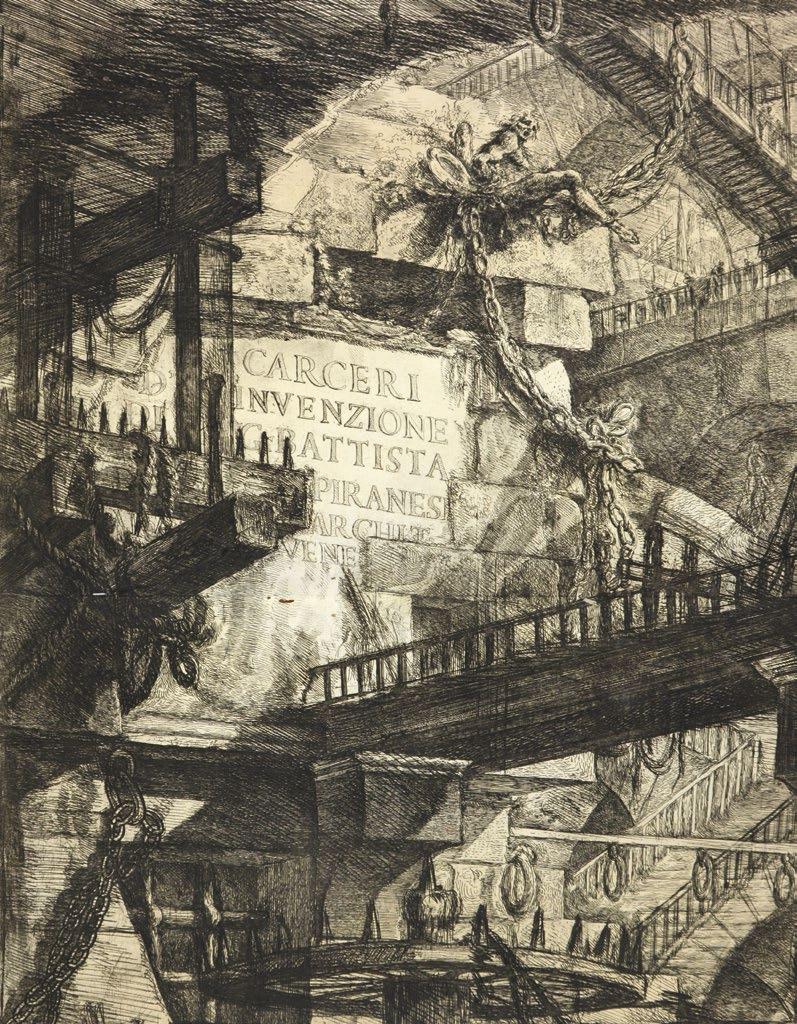
Shapero Rare Books 32 Saint George Street, London W1S 2EA Tel: +44 207 493 0876 • rarebooks@shapero.com • www.shapero.com 50 Fine Books Autumn 2015
aCKeRmaNN, Rudolph. A History of the University of Oxford, its colleges, halls, and public buildings.
R. Ackermann, London, 1814.
One Of fifty large paper cOpies Of the finest cOlOur-plate bOOk On OxfOrd
Among the most celebrated of the topographical illustrations with which Ackermann followed his Microcosm of London, was a trilogy of works on the English universities and public schools. Oxford was the first of these.
The text of Ackermann’s books was provided by William Combe (1741-1823). After a youth largely spent squandering his father’s fortune, Combe had embarked upon a career as a writer in 1770s. More or less confined to a debtor’s prison in the early 1800s, Combe had effectively become Ackermann’s house writer after authoring the final volume of the Microcosm, and produced a steady flow of verse and prose for Ackermann including the text for the popular Dr. Syntax books.
Ackermann’s books were issued in relatively small editions of around 1000 copies, but the production of such fully illustrated works called for an extensive network of artists and craftsmen as well as a workshop of some size. The drawings and engravings were produced on a commission basis, and the letterpress executed by a firm of printers nearby. Only the printing and colouring of the illustrations themselves was done in Ackermann’s workshop. The labour and expense of all this was considerable. It is not surprising that these books, then as now, were priced as luxury objects. Oxford sold for £8 when completed in two volumes. 50 copies were produced on large paper and these sold for £11 (Lowndes, Bibliographer’s Manual). These copies give a gloss, an incomparably rich glow absent from small-paper copies fine as these are in early impressions; their text is also on thick Whatman paper which contributes to the luxurious feel of the books.
The issue point for plate 1 is amusing: in the earlier state (as here) the imprint states that the view of Oxford was printed for Ackermann’s History of Cambridge.
First edition. 2 volumes, elephant quarto, large paper cOpy (42 x 34 cm.), portrait engraving of Lord Grenville on india paper (foxed) and 114 hand-coloured plates plates comprising 81 finely hand-coloured views of the colleges, etc. (64 aquatints and 17 line engravings), together with 33 hand-coloured line and stipple plates of the founders; plates and text watermarked J. Whatman, 1811; plates 1, 15, 39, 50, 78, 84, & 94 in first state, plate 74 in second state. Finely bound in contemporary russia gilt super extra, covers with broad borders in gilt and blind, spines in six compartments, gilt lettered direct in second and fifth, others richly gilt, broad raised bands gilt, broad inner dentelles gilt, all edges gilt, a choice set. Abbey Scenery 278; Tooley pp13-18; Prideaux p331; Martin-Hardie pp104-6.
£8,500 [ref: 92064]
6 Shapero Rare Books
1.
RaRe laRge papeR example

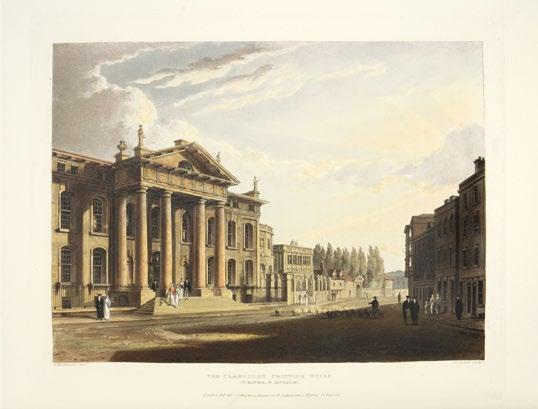
7 Shapero Rare Books
2. aNgaS, George French. The Kafirs illustrated in a series of drawings taken among the Amazulu, Amaponda, and Amakosa Tribes; also portraits of the Hottentot, Malay, Fingo, and other races inhabiting Southern Africa; together with sketches of landscape scenery in the Zulu Country, Natal, and the Cape Colony. Hogarth, London, 1849.

first editiOn Of this impOrtant wOrk, including Outstanding pOrtraits, particularly of the Zulus. The plates also include views of Cape Town, Hottentot Holland, Somerset West and Durban.
‘The three large works by George French Angas, the Kafirs, New Zealanders and South Australia are amongst the most important of the illustrated travel books of their period... Of the three works, the Kafirs is the most uncommon’ (Tooley).
Angas, born in Newcastle in 1822, travelled to South Africa in 1847. He next spent two years there, and in 1849 published the present work, several of the original drawings for which were bought for the print-room of the British Museum. In the introduction, he remarks ‘I have had more real enjoyment of existence … during the many months I have passed amongst Kafirs and New Zealanders, than I ever had amid the anxieties and conventionalities of a more refined life.’
First edition. Folio (54 x 36.5 cm. approx.), lithographed portrait on india paper, 30 hand-coloured lithographed plates by Angas, Needham, Laby, and others after Angas, wood-engravings in the text, occasional light soiling, contemporary black half morocco gilt, rebacked preserving spine, cloth sides renewed, morocco label to upper cover, a very good copy.
Abbey Travel 339; Colas 134; Gay 3157; Mendelssohn I, 45-46; Tooley 60.
£11,000 [ref: 92940]
8 Shapero Rare Books
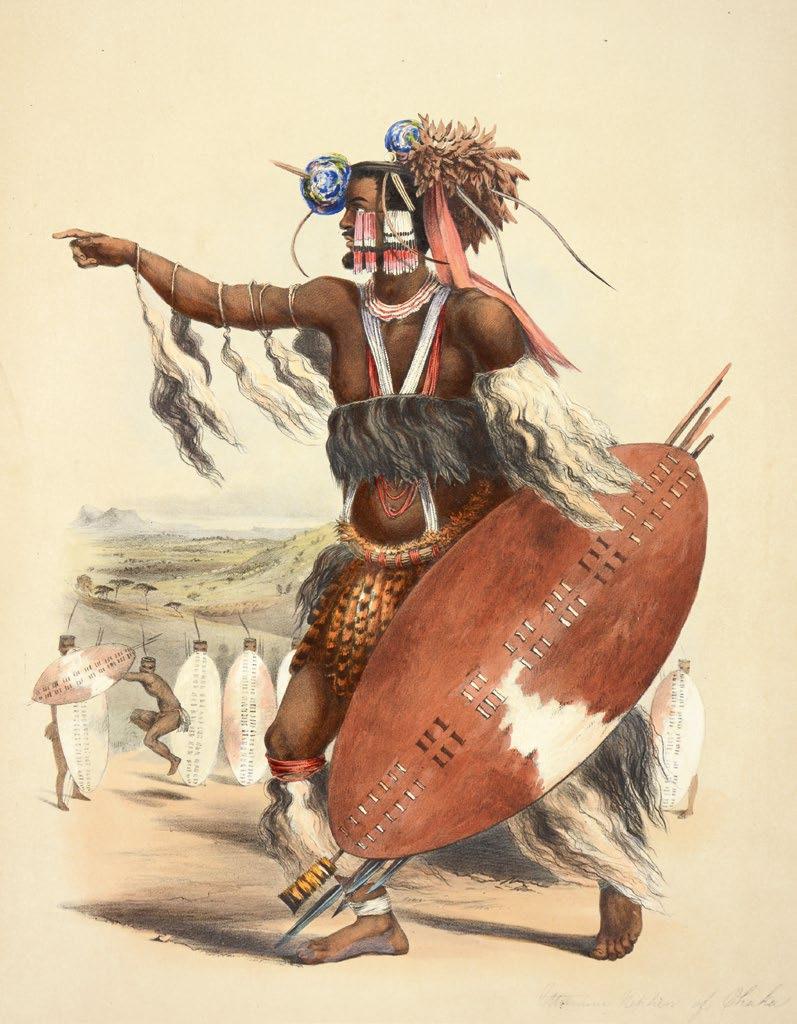
3. aTKINSON, James. Sketches in Afghaunistan. Graves, London, 1842.

the rare deluxe issue with the illustratiOns printed On fine paper and mOunted On card.
One of the classic illustrated books on Afghanistan. The plates include fine views of Kabul, Ghuznee, Kwettah, etc. and the work provides a valuable pictorial record of what was then an unexplored country.
Accomplished in literature and art, both a scholar and a popular writer, James Atkinson (1780-1852) was a pioneer of oriental research. He had originally studied medicine and it was in this capacity that in 1838 he was appointed superintending surgeon to the army of the Indus, and accompanied it on its march to Kabul. Fortunately for him, he was relieved shortly after the surrender of Dost Mohammad, and, returning to Bengal in 1841, escaped the fate which awaited the army of occupation.
First edition. Large folio 57x 46.5cm. approx., title-page vignette and 25 lithographs all hand coloured and mounted on card as issued, complete with list of plates printed in blue, a fine fresh copy, original dark red half morocco portfolio, morocco lettering piece to upper cover, an excellent example. Abbey Travel 508; Colas 173; Lipperheide 1493; Tooley 73.
£30,000 [ref: 91899]
10 Shapero Rare Books

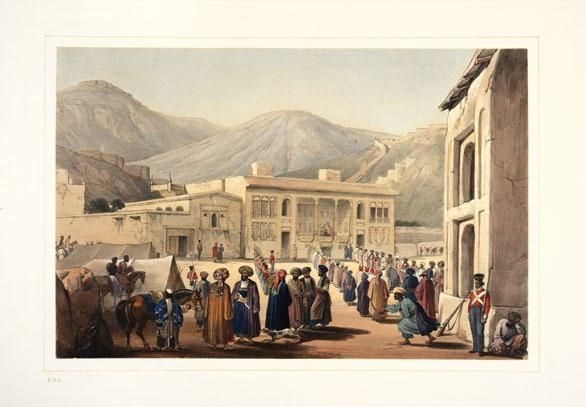
11 Shapero Rare Books
4. B aSTON, Thomas. Twenty-two prints of several of the capital ships of his Majesties Royal Navy with variety of other sea pieces.

Carington Bowles, next the Chapter House in St Pauls Churchyard, London, 1721.
a rare and beautiful series Of prints Of the ships that built an empire
“During the first quarter of the eighteenth century there flourished Thomas Baston, who deserves our attention because he has left us some very spirited illustrations of English men-of-war. Himself a seascape painter, he also did a few etchings from his own designs, but some of his pictures were engraved by Harris, Kirkall, and others. A desirable Baston series is that entitled Twenty-two Prints of several of the Capital ships of his Majesties Royal Navy, which will be found in the Print Room of the British Museum.” (E.
Keble Chatterton).
First edition. Folio (52 x 37.5 cm), engraved allegorical title-page, 21 engraved naval plates, one double-page, one folding, contemporary sprinkled calf, sometime rebacked, neat restoration to corners and edges, front free endpaper creased, light staining to blank outer margin of first plate, pinhole paper flaw to one plate, an excellent example.
£15,000 [ref: 92955]
12 Shapero Rare Books


13 Shapero Rare Books
5. BeggROW, Charles [Карл Петрович БеГГров]. Собрание рисунков
изображающих
разнощиков
в С. Петербурге. Cris de St. Petersbourg, Collection de petits dessins a l›usage de la jeunesse.
Saint Petersburg, 1834.
aTTRaCTIve SeT Of IlluSTRaTed C aRdS, veRy RaRe aS SuCh: COmpleTe, fReSh, WITh paRTICulaRly fINe haNd COlOuRINg. OCLC locates no copies in institutional holdings and the great Russian collector Pavel Gubar could only find a group of 11.
With his workshop based on Nevsky Prospekt, Beggrow (1799-1875) was one of the greatest Russian lithographers, distinguishing himself especially from his direct competitor Pluchart thanks to a more accomplished, refined style. Taking on a tradition dating back to the 18th century, he shows in this lovely collection various street vendors to be found in St. Petersburg, the contrasted capital of Golden Age Russia where Pushkin, Gogol and some other of the greatest Russian writers were attending enlightened debates and brilliant balls.
The cards are finely drawn and were coloured by hand in Beggrow’s studio; while the French captions describe the vendor himself, the Russian ones focus rather on the item sold and evoke what could be heard - see for example the ‘Laitiere’ (milkmaid, actually present in two versions), captioned in the native simply as ‘milk, fresh milk’, both times. Besides usual professions (such as the fish monger and the florist), the cards also show the extent of the Russian empire, mentioning Moscow prints and biscuits, Tatar cloth and Kazan boots. Some very specific Russian products can also be found, such as the famous kvass, a drink based on fermented bread.
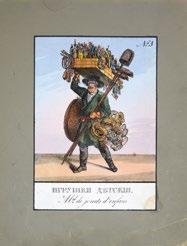

The set is unusually presented by the contemporary owner in an attractive album.
Provenance: Boris Berezovskiy (1946-2013, Russian businessman and politician).
Twenty-four numbered lithographed cards (12.5 x 9.5 cm), with fine contemporary hand-colour heightened with gum arabic, captions in Russian and French, all cards pasted on individual leaves with background coloured by contemporary hand. Contemporary quarter calf over marbled boards, leather label with gilt lettering to upper board; slightly rubbed, corner bumped, light markings in pencil to lower board. Gubar 3037-47 (only 11 cards, in worse condition; illustrated p. 193).
£10,000 [ref: 92262]
14 Shapero Rare Books
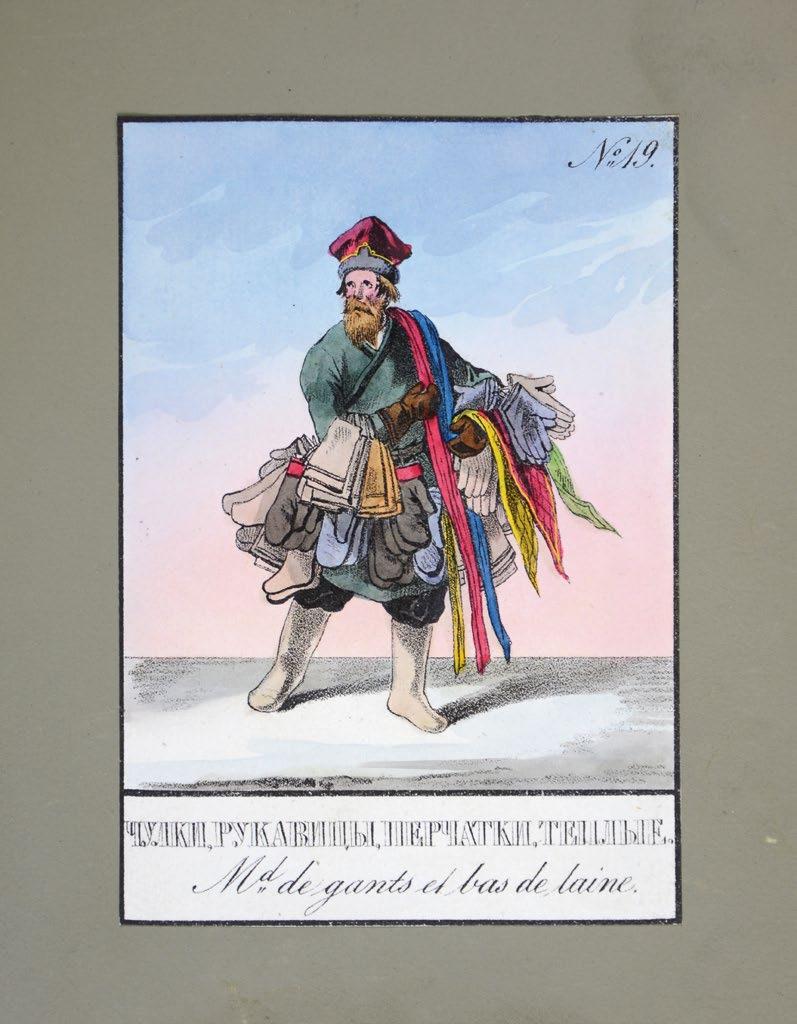

item 6
- The Burghley Blaeu.
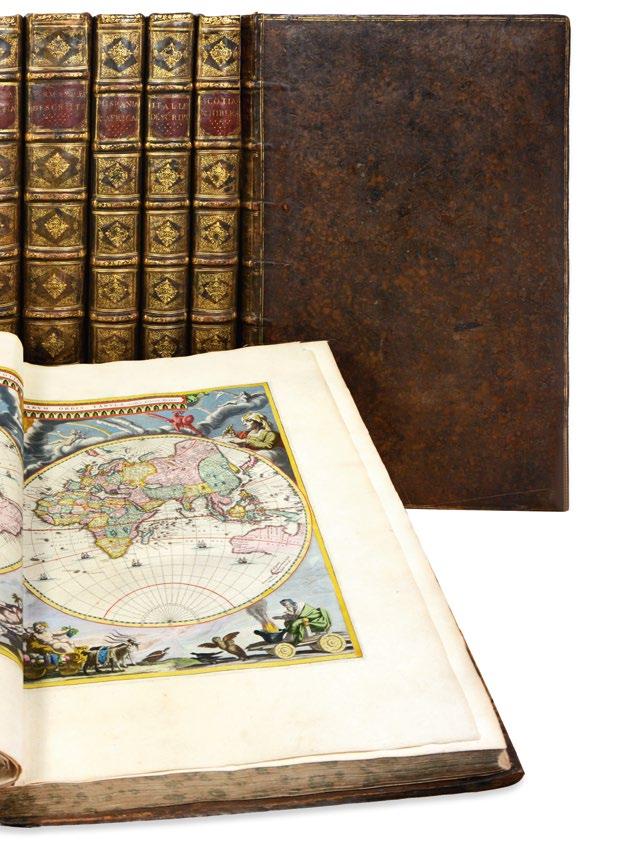
The aTlaS haS OuTSTaNdINg eNglISh pROveNaNCe, IN The Same famIly fOR almOST ThRee huNdRed yeaRS aT BuRghley hOuSe, the largest and grandest Elizabethan house in England. It was built for Sir William Cecil, later 1st Baron Burghley, who was Lord High Treasurer to Queen Elizabeth I, between 1558 and 1587.
The Blaeu Atlas was added to the library by John Cecil, 5th Earl of Exeter, (1628–1678). One of the first to popularize the ‘Grand Tour’ he was a notable art connoisseur and filled his family home with treasures purchased on his travels in Italy. He had married Anne Cavendish the only daughter of the 3rd Earl of Devonshire and widow of Lord Charles Rich. As daughter of one of the richest men in England and widow of another, she brought further wealth into the Cecil family, which included a large collection of jewellery, furniture, plate and porcelain.
The fifth Earl was the later of two notable Cecil book collectors. the first Baron Burghley (1521-98), gathered an extensive library with some important manuscripts. The fifth Earl acquired important books published in the 15th to 17th century, which were kept in Burghley House until the mid-20th century, explaining the fine state of conservation of this copy of Blaeu’s Atlas.
the present cOpy is a superb example befitting such a grand hOuse, with wide margins and vibrant cOlOur
With 594 hand-coloured engraved maps in 11 volumes covering the entire known world, the Atlas Maior was also the largest and most expensive book published in the seventeenth century. With its high typographic standard, lavish presentation in vivid colours, and often luxurious bindings, Blaeu’s Atlas remained the standard world atlas and premier product of the Dutch publishing industry, the most prestigious in the world, for over a hundred years and frequently served as the official gift of the Dutch Republic.
The atlas is justly famed for its ‘carte-aux-figures’ maps of the continents, the 58 maps devoted to England and Wales, the first printed atlas of Scotland, the suite of 25 maps of America, including important early maps of Virginia, New England and Brazil, and Martini’s Atlas of China, the first European atlas of this country.
The scale and success of Blaeu’s atlas is due in no small part to the impetus provided by the fierce competition between the Blaeu and Janssonius publishing houses. Until the late 1620s, the European market for world atlases was dominated by the Mercator maps published by Jodocus Hondius II and, later, by Johannes Janssonius. However, following Hondius’ death in 1629, and the growing competition in publishing sea charts and pilot books, the Blaeu business seized its opportunity to publish a grand world atlas: Theatrum Orbis Terrarum or Atlas novus.
The project did not get off to a swift start and, at the time of the death of Willem Janszoon Blaeu (1571-1638), only two volumes had been published. However, his eldest son, Dr Joan Blaeu had joined the business in the 1630s and continued the task, publishing a volume for Italy in 1640, one for England in 1645, and another for
18 Shapero Rare Books
6. Blaeu, Joannes. Atlas maior, sive Cosmographia Blaviana, qua solum, salum, coelum, accuratissime describuntur. Blaeu, Amsterdam, 1662-65.
fIRST laTIN edITION Of “The gReaTeST aNd fINeST aTlaS eveR puBlIShed” (KOemaN).
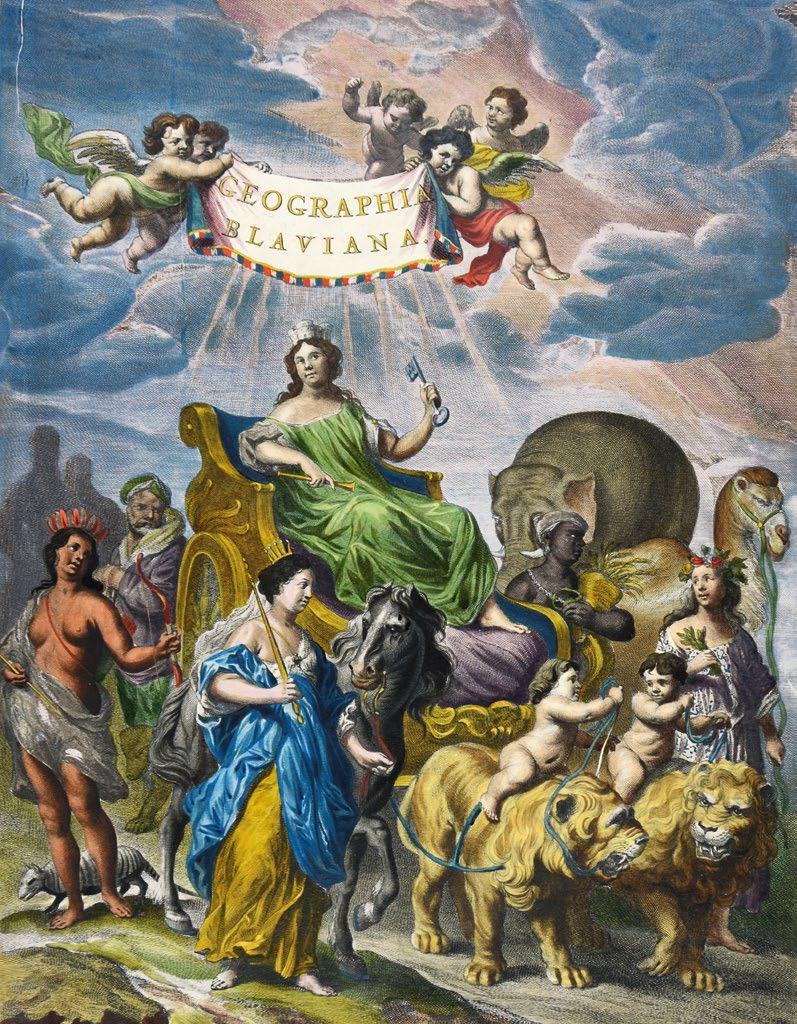
Scotland in 1654. In doing so “Joan Blaeu eclipsed his chief rival, Johannes Janssonius, who, from this time, never matched the quantity of volumes and maps in Blaeu’s magnificent atlas” (Fleet).

In 1662 Joan Blaeu published this famous Atlas in Latin - the version offered here. This was followed by editions in French (12 vols.), Dutch (9 vols.), Spanish (10 vols.) and German (10 vols.). The detailed collation is available on request.
Provenance: ‘The Right Honourable John Earle of Exeter Baron Cecil of Burghley’ (armorial bookplate on title versos, with motto ‘Cor unum, via una’; Highly Important Printed Books and Manuscripts from […] the Marquess of Exeter, Burghley House, Christie, Manson & Woods sale, 15 July 1959, lot 127, sold £1,050 to Hammond (most probably Frank Hammond, bookdealer), described as “finely coloured by a contemporary hand, some heightened with gold […] a fine copy”).
Eleven volumes folio (57 x 37.5 cm). With 10 title-pages and allegorical titles illuminated in gold and colours, 594 double page maps and plans, as well as many engravings in the text, all in superb contemporary gouache colour; only very few leaves slightly browned. Contemporary mottled calf gilt, red morocco gilt title-pieces, probably bound for the Earl of Exeter; spines rebacked and restored, keeping the lettering pieces. Koeman I. BL 56.
£500,000 [ref: 91948]
20 Shapero Rare Books

21 Shapero Rare Books
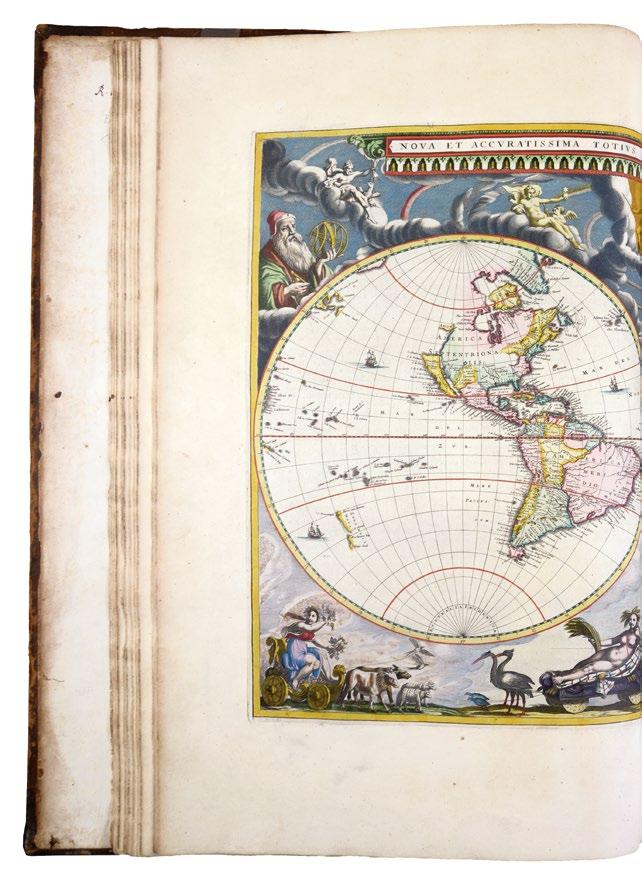
item 6 - The
Burghley Blaeu.

Boeckler (1617–1687) was an architect in the city of Nuremberg and specialized in hydraulic architecture. Architectura Curiosa Nova was his most important work. It is mainly a book on theory and application of hydrodynamics for fountains, water-jets, garden fountains and well heads with many designs for free-standing fountains. The fourth part includes designs for grottoes and garden pavilions.
Provenance: Earls of Macclesfield (armorial bookplate and blindstamp).

First edition in Latin. Folio. Engraved additional title, 200 engraved plates (1 folding), printed title in red and black, contemporary mottled calf gilt, covers with borders decorated in blind, spine in seven compartments, joints repaired, new label, an excellent copy. Berlin Kat. 886; Millard 8.
£4,000 [ref: 91912]
24 Shapero Rare Books
7. BOeCKleR, Georg Andrea. Architectura Curiosa Nova. Pauli Furst, Norimbergensis, [1664].

25 Shapero Rare Books
8. BROOKe, e. Adveno. The Gardens of England. T. McLean, London, [1857].
a rare, large fOrmat wOrk prOviding superb depictiOns Of english cOuntry hOuse gardens in victOrian times, and giving an insight intO the taste Of the great estate Owners
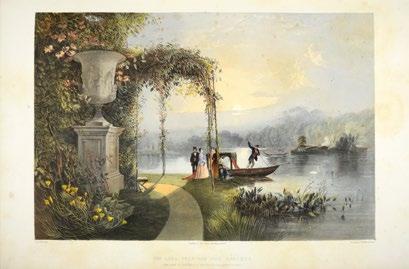
Many of the gardens were begun in earlier times, but most feature later additions, sometimes in the Italian style, which proved a major attraction for Brooke.
The magnificent gardens depicted include those at Trentham Park (laid out by Capability Brown with additions by Charles Barry in the 1840’s), Enville Hall (gardens extended in the mid-nineteenth century and celebrated for its fountains, its floral display, and its domed and turreted oriental palace of a conservatory), Bowood House (originally laid out by Brown but with later Italianate terraces added), Alton Towers (“The work of a morbid imagination joined to the command of unlimited resources” (J. C. Loudon), Elvaston Castle (famous for its splendid arboretum), Shrublands Hall (Italianate terraces by Barry), Woburn Abbey (a Repton masterpiece), Holkham House (William KentCapability Brown, with extensive 1850’s additions including a parterrre with the Earl of Leicester’s initials in box, and a pair of flower beds in a Louis XIV pattern accompanying a fountain representing St. George and the dragon), Castle Howard ( whose modern additions included a new parterre using yew hedges to frame the lawns and the Triton Fountain taken from the Great Exhibition), and many others.
Brooke was an exhibitor at the Royal Academy and British Institution in the period between 1853 and 1864.
Provenance: Annie, Viscountess Cowdray (1881-1932, wife of Weetman Dickinson Pearson, 1st Viscount Cowdray; bookplate).
First edition. Folio (54 x 37cm.), title-page and 25 lithographed plates printed in colours and finished by hand, heightened with gum arabic, lithographed dedication leaf, letterpress text, 16 lithographed vignettes on india paper pasted into text, original green morocco-backed cloth, title within leafy frame stamped in gilt on upper cover. Abbey, Scenery 392.
£25,000 [ref: 92918]
26 Shapero Rare Books
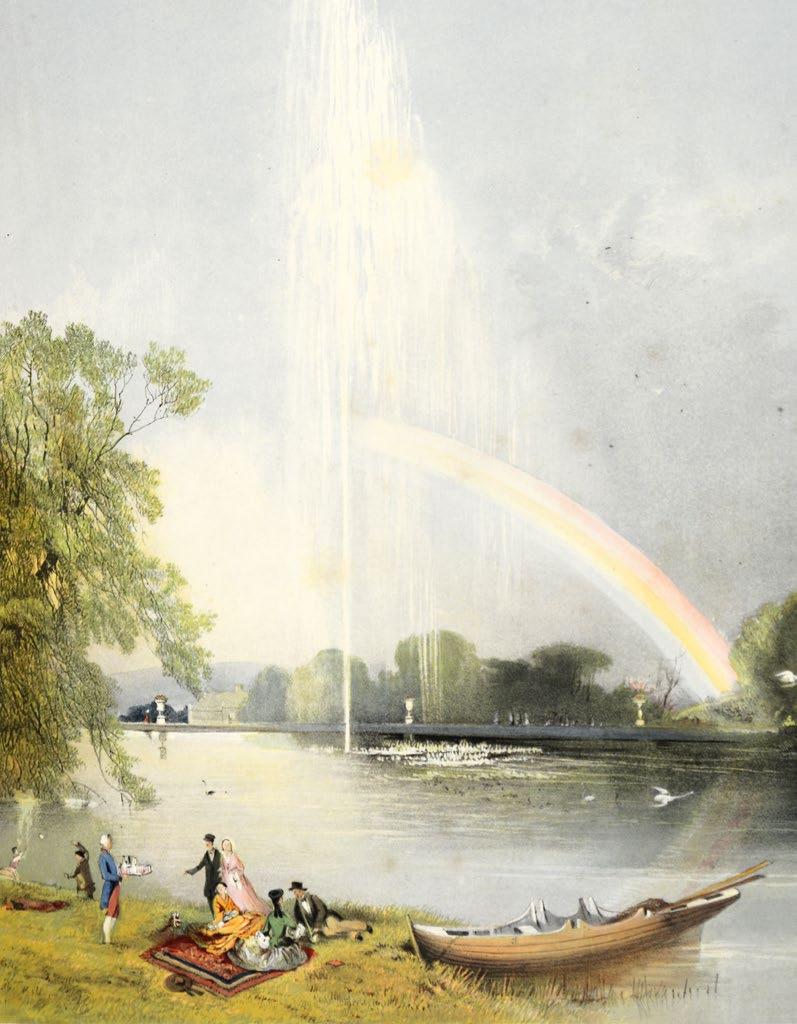
9. C ampBell, Colen. Vitruvius Britannicus, or the British architect, containing the plans, elevations, and sections of the regular buildings, both public and private in Great Britain.
The Author, London, [1731]-31-67-71.
the finest wOrk Of cOuntry hOuse illustratiOn in great britain superb perspective views and plans Of all the great mansiOns.
The first volume of Vitruvius Britannicus, appearing in the same year as Leoni’s Palladio, was the earliest manifestation of the new Palladian revival - it was, in fact, Campbell who kindled the flames of Burlington’s interest. The continuation of the series under Woolfe and Gandon (vols. 4 & 5) belongs to a much later phase of Palladianism. The five volumes together illustrate the evolution of the English country house from the great palace to the smaller villa.
Vitruvius Britannicus is indispensable for the study of 17th and 18th-century architecture in England, and it occupies its own special place in architectural history as the book which established Palladian architecture as the approved style for Britain in the 18th century. Colen Campbell issued the first three volumes between 1715 and 1725, while the Woolfe and Gandon volumes of 1767 and 1771 are a continuation illustrating work by Burlington, Kent, Ware, John Wood, Chambers, Adam and Paine. They contain in all 385 large engraved illustrations, plans and sections of palaces, country houses, government offices and churches designed by architects from Inigo Jones onwards, with extensive coverage of Wren and Vanbrugh and of Campbell’s own designs in the new English Palladian style.
Provenance: 1. Old ink inscription of “P.N.Baker Banston 1798” at head of title of volume (engraved armorial bookplate). Sir Edward B. Baker, engraved armorial bookplate.
Five volumes in 2, folio, volumes 1-3 later editions, volumes 4 & 5 first editions, engraved titles in all but volume 3 (that in red and black), titles of volumes 1 & 2 in third state without imprints, titles and text all in English and French, engraved dedications in all but volumes 2 & 3, volumes 4 & 5 with lists of subscribers, 491 engraved plates on 385 sheets (of 493 on 386, lacking as usual the double-page plate of Umberslade at end of volume 3), including 91 double-page plates and 5 quadruple, title very lightly soiled and some occasional light offsetting but generally an excellent clean example. Contemporary mottled calf; a little rubbed, rebacked preserving old red and black roan labels, some corners repaired. Berlin 2329; Colvin p. 209 Fowler p62; Millard, British Books, 10.
£22,500 [ref: 92138]
28 Shapero Rare Books


29 Shapero Rare Books
10. [CHINESE SCHOOL] - Album of ink drawings. [Canton, 1840s].

fine cOllectiOn Of Original drawings shOwing chinese ceremOnies, scenes frOm the imperial cOurt, pOrtraits Of chinese nObility, musical instruments, traders and craftspeOple, each captiOned in english
In the mid XVIII century the Emperor Qianlong implemented the Canton System (1757–1842) in China, closing the ports across the country to focus all trade on the southern port of Guangzhou. The Pearl River delta region then became the centre for China’s commerce and export industry, which gave a push to the development of an
30 Shapero Rare Books
artisan industry. Numerous craftspersons and artists in Canton were commissioned to produce various artworks for the European market. They “depicted those phases of Chinese life which fascinated the Westerner but defied descriptions to friends and family at home. Before the advent of the camera, this medium played an extremely vital role in revealing Oriental culture to the West.” (Crossman, The China Trade, 1972).
Landscape quarto (27 x 29 cm). 118 ink drawings, each drawing on one side of fine double-folded paper with manuscript caption in English; several small marginal tears, some spotting to one page. Contemporary pink wrappers; with tears and marginal losses.
Alison Hulme, The Changing Landscape of China’s Consumerism (Oxford, 2014).
£12,500 [ref: 92726]
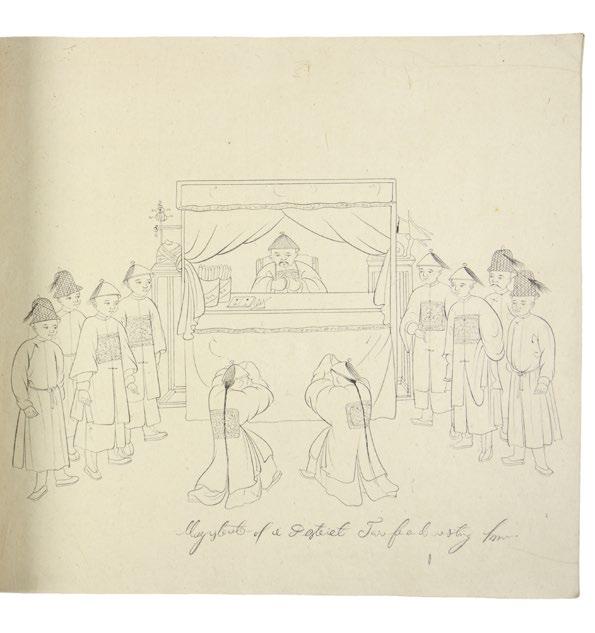
31 Shapero Rare Books
a very fine example Of painting On pith paper. The subjects include fruit, lowers, and vegetables, such as ginger, radishes, pomegranate, corn, lychee, peppers, breadfruit and pumpkin. It is particularly desirable as it bears the painter’s red seal, in this case Yoeequa, of Old Street, No. 34. An album by the same artist in the Bibliotheque National is dated to circa 1835.
Pith seems not to have been adopted for painting until about 1820. Some European museums claim that their paintings on pith (often erroneously called “rice paper” or “mulberry pith”) come from the end of the eighteenth century but there do not seem to be any dateable examples that are so early. There is a record of the Kaiser Franz of Austria buying some albums from an English Consul-General Watts in 1826. We know of an Italian Count who visited Canton in 1828 and had over 350 paintings on pith in his baggage when he died in Ambon two years later. In the British Library there is a scrap-book containing six pith paintings and a journal entry by a serving British officer who sent them home from India in 1829. These examples and contemporary accounts by visitors to Canton suggest that there was a flourishing trade in pith paintings by the early 1830s.
Pith presumably came into use for painting to satisfy the increasing demand for small, inexpensive and easily transported souvenirs, following the massive growth in the China Trade in the first quarter of the nineteenth century. Paintings in oils, on board and canvas were costly and difficult to carry home. Earlier and more prestigious export water-colours had often been on a larger scale and painted on fine Chinese paper or on paper imported from Europe. The albums of pith paintings (and later the little glass-fronted boxes) were inexpensive, light, easy to pack and gave the pictures some protection on the long voyage home. Because many were sold in albums and hence protected from the light, they retain their bright colours to this day.
Pith comes from the central column of spongy cellular tissue in the stem of a small tree called Tetrapanax Papyrifera, native to south-west China. It has had a variety of uses, some going back many centuries. At the imperial court both men and women wore coloured flowers made from pith in their hair. For use in painting, it is cut by hand with a knife into thin sheets from short lengths of the spongy tissue. Cutting is highly skilled and the constraints of the process mean that the finished sheets for painting seldom, if ever, measure more than about 30cm by 20cm. The sheets are dried, trimmed and used for painting without any further processing.
Because of the nature of pith and its cellular structure, the gouache used by the Chinese sat on the surface and produced a bright and even sparkling effect. Very fine detail could be achieved but pith did not lend itself to the flat wash of colour favoured for European watercolours.
Landscape 4to (24.5 x 32 cm.), 9 fine watercolour drawings on native paper mounted with silk borders in a European album with embroidered silk covers.
£12,500 [ref: 92058]
32 Shapero Rare Books
11. yOeeQua. Botanical drawings on pith paper. [Canton, c. 1835].

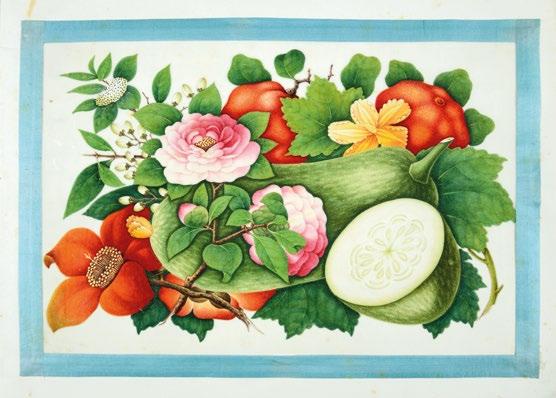
33 Shapero Rare Books
12. CuRTIS, William. The botanical magazine; or flower garden displayed. London, 1787-1866.
a unique set arranged by linnean classes.
‘The Botanical Magazine became a primary source for the study of the history of gardening tastes and methods, and of plant introductions. This, combined with the work of some of the greatest botanical artists, means “the reputation of the magazine has always resided in the accuracy of its portrayal of plants... this pictorial record of garden and greenhouse plants from the temperate and tropical regions of the world has no rival...’ (Desmond, p.7). The work was immediately successful, (its publication continuing almost without interruption until 1983), endorsing Curtis’s theory that his clients, who refused to buy folio pictures of unassuming plants, would subscribe to an octavo work which pictured showy plants that filled their gardens.

34 Shapero Rare Books
SeT uNIQuely aRRaNged By lINNeaN ClaSSeS
Provenance: R[ichard] Bright (1754-1840 ink ownership inscription dated 1789 on first title).
27 vols, 8vo (24.5 x 15cm). Volumes I - XCII, together with indexes and a volume of Companion pieces to the periodical, divided into Linnean Classes and bound thus.Approximately 3,700 hand-coloured engraved plates, many folding. (Lacking three bound vols from vols I-XX and one from vols 54-88, occasional variable very light spotting, offsetting and browning.) Late nineteenth/early twentieth-century half calf over marbledpaper covered boards by the Workshop for Cripples, 111 Shaw St, Liverpool, flat spines ruled in gilt, uncut Hunt 689; Nissen BBI 2350; Stafleu & Cowan 1290; Blunt (1994),pp.211-217; Great Flower Books (1990), pp.156-7. See also R. Desmond A celebration of flowers: two hundred years of Curtis’s Botanical Magazine [London]: Royal Botanic Gardens, 1987.
£18,500 [ref: 91029]
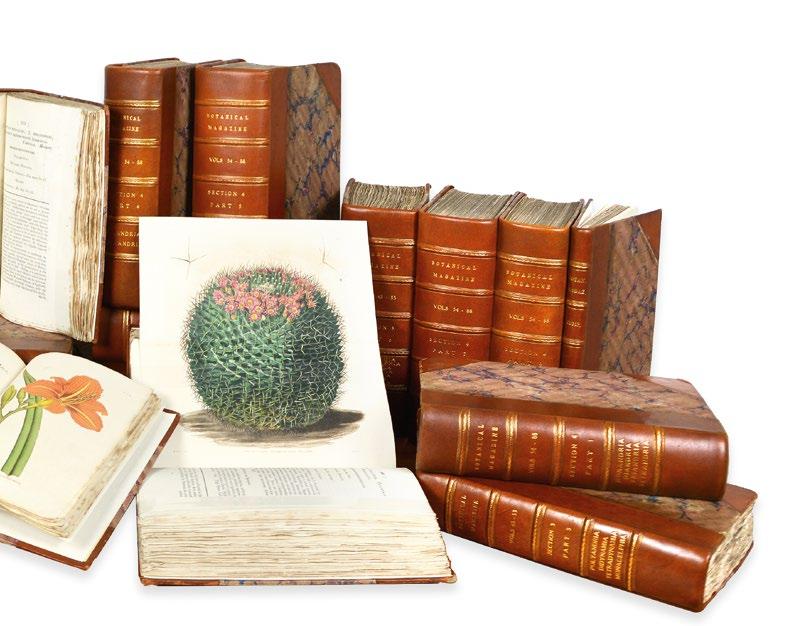
35 Shapero Rare Books
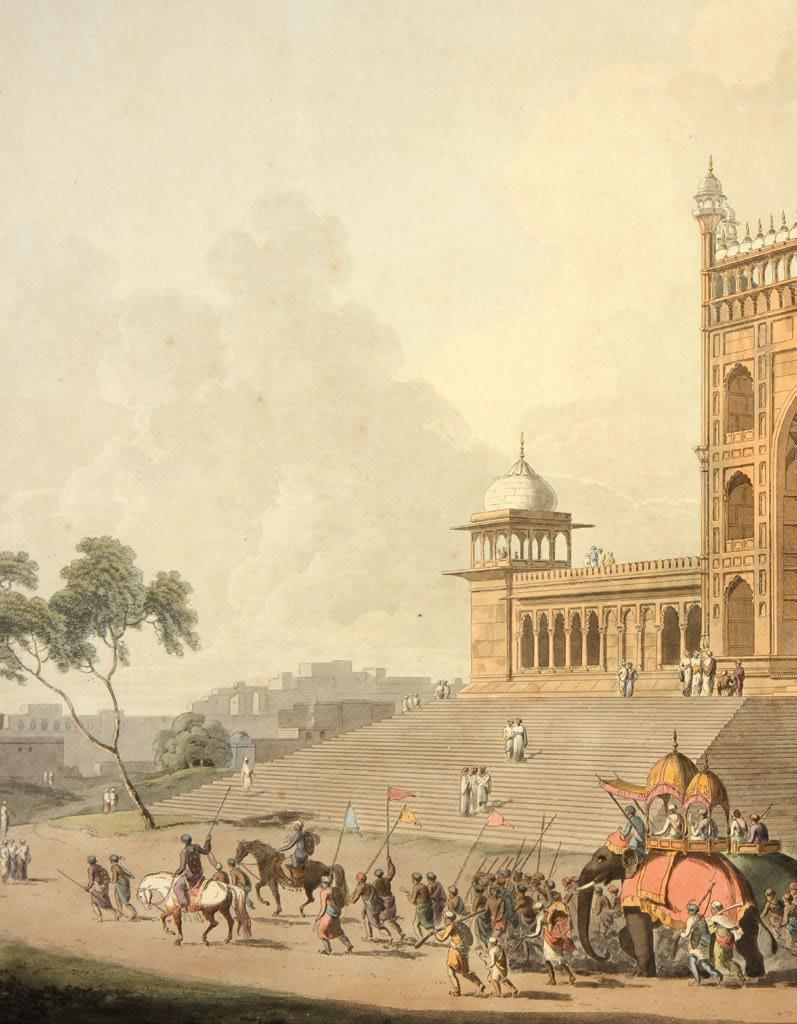
item 13
- Daniell, Thomas and William. Oriental Scenery.

“The majOR WORK Of The WhOle aQuaTINT epISOde”. - Franklin.
This was the Daniells’ most important work, showing fine views of scenery and accurate architectural representations along the route of the Daniells’ journey to India and during their stay in Calcutta. The brothers ventured further than any other previous artist and managed to produce hand-coloured aquatints which captured the subtlety of the watercolours. A most influential work causing Repton to redesign the Pavilion at Brighton and causing Turner to write apropos of his Liber Studiorum engravings: “I should like to have them engraved like Mr. Daniell’s”.
Part 1 shows the glories of Delhi, of Allahabad, of Secundra, of Rotas Ghar, of the Taj Mahal; Part II includes the famous views of Calcutta, Madras and Trichinopoly; Part III contains beautiful views of the mausoleums etc.; Part IV includes Lucknow, Allahabad, and Juanpore; Part V is engraved by the Daniells after drawings by James Wales, and contains illustrations of Indian antiquities; Part VI contains the fine three-plate panorama of Ellora, and the two-plate panorama of Kailasa.
The Daniells were among the most important European artists documenting the Indian subcontinent for European eyes. “Not only are we given the architectural beauties of little-known countries at a time when architecture of this type was a subject of keen interest, but we have landscapes in the true romantic styles. Each plate is carefully composed. The human element, however, is seldom absent, whether it be an encampment of Europeans, a group of Indian boats, a formal procession... It is this incorporation of human elements that has given rise to the noted similarity of grouping between Canaletto and Thomas Daniell. Apart from their artistic merit the plates are of the greatest value for their historical and architectural accuracy, recording as they do buildings now demolished and places altered beyond recognition. It still remains as the finest work on India ever published.” - Sutton.
This work rarely appears on the market complete. The original price of 200 guineas (210 pounds), meant that few people would have been able to even contemplate purchasing a set, and the numbers produced would have been small. Taking into account the ravages of time, and the frequency with which volumes are broken for the engravings, it is easy to understand the scarcity of this work. The present copy presents a wonderful opportunity to acquire one of the greatest masterpieces of the art of the book.
Provenance: Norman Bobins (bookplate).
Price on request [ref: 92038]
38 Shapero Rare Books
13. DANIELL, Thomas and William. Oriental Scenery. Thomas Daniell, London, 1795-1808.
First edition. Six volumes, large folio (83 x 60 cm), six sepia aquatint title pages, 144 hand-coloured aquatints on thick paper, drawn and engraved by Thomas and William Daniell (Part IV the plates after drawings by James Wales), mounted on stubs and interleaved with plain paper guards throughout, modern half calf gilt, an excellent set.
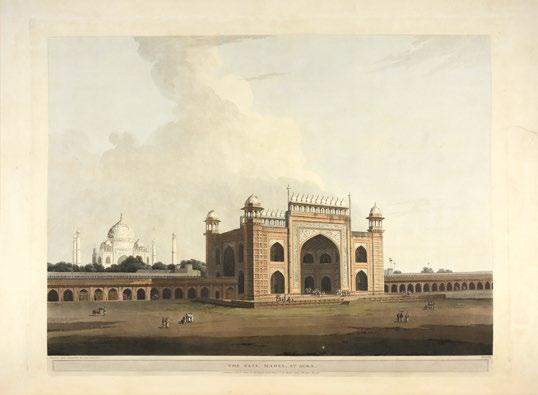

39 Shapero Rare Books
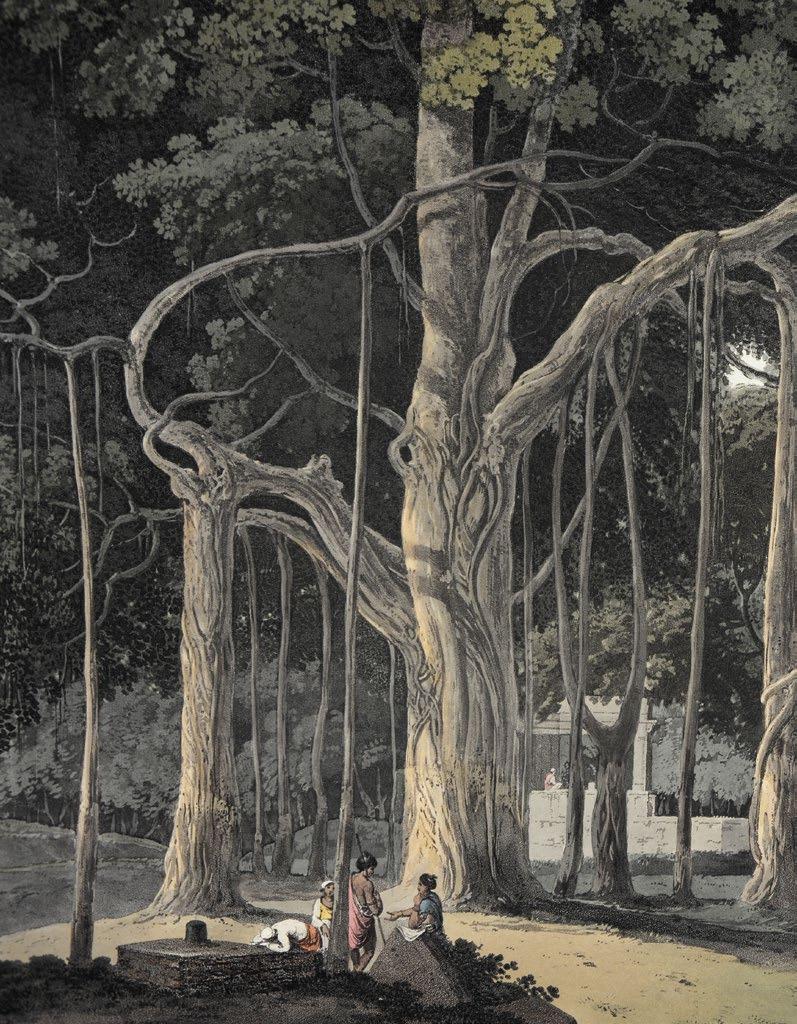 item 13 - Daniell, Thomas and William. Oriental Scenery.
item 13 - Daniell, Thomas and William. Oriental Scenery.
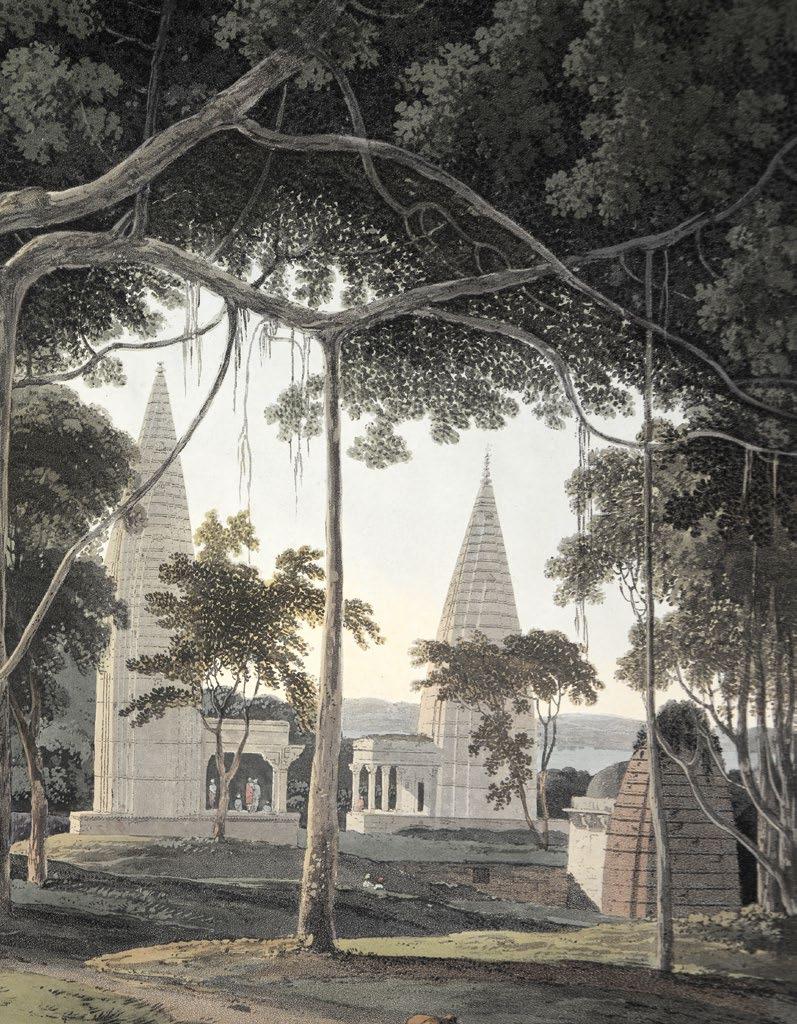
14. daNIell, William; Richard AYTON. A voyage round Great Britain, undertaken in the summer of the year 1813, and commencing from the Lands-End, Cornwall, by Richard Ayton. With a series of views, illustrative of the character and prominent features of the coast, drawn and engraved by William Daniell, A.R.A. Longmans, London, 1814.
a cOmplete set Of ‘the mOst impOrtant cOlOur plate bOOk On british tOpOgraphy ’ (Tooley).
William Daniell and Richard Ayton’s Voyage around Great Britain was one of the most ambitious and lavishly realised topographical undertakings of the early 19th century. The series of eight volumes of aquatints accompanied by extensive texts was published between 1814 and 1825.
Daniell and Ayton began their journey around the country in 1813, but the partnership survived only the first two volumes. Ayton was more concerned with social observation than topographical record and his writing often bears little relevance to Daniell’s landscapes. After they parted company Daniell provided the text as well as the pictures.

Provenance: Book-label of George Rennie on front pastedowns,
First edition, 8 volumes bound in 4, aquatint dedication, 308 hand-coloured aquatints by and after Daniell, each within grey wash border, without the one uncoloured aquatint plate of ‘Kemaes Head’ in vol.1 but with the folding map at end of vol.8, errata leaf at end of vol. 1, vol.1 with 2 leaves (pp.123-126) on thicker paper, frontispiece to vol. 2 misbound in vol.3, plate of East Looe in vol. 8 with some foxing, otherwise a very clean set. Handsome contemporary burgundy straight-grain morocco, by Fairbairn & Armstrong, gilt borders of oak leaves and acorns, spines gilt in compartments, gilt edges, rubbed, scratches to boards, repairs to joints and corners, etc.
Abbey 16; Sutton 28; Tooley 177; Upcott p.xxxv
£17,500 [ref: 92938]
42 Shapero Rare Books
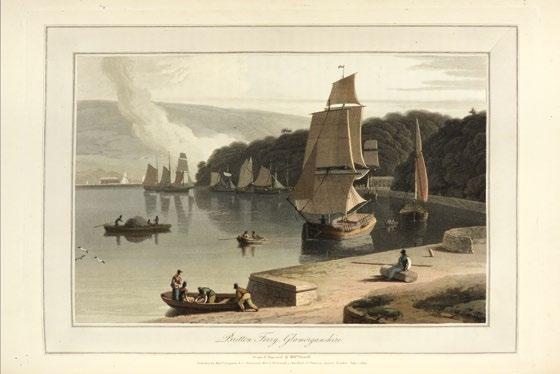
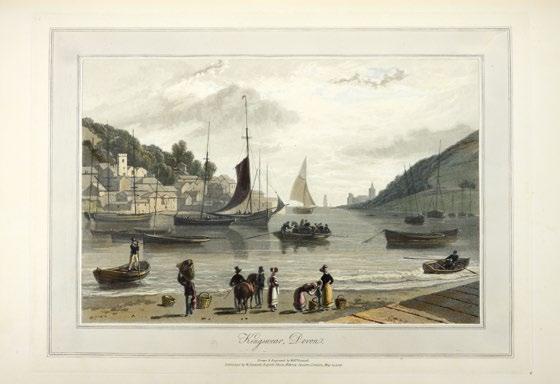
43 Shapero Rare Books
15. gÄRTNeR, Frederic. Vues des principaux monuments grecs de la Sicile... [Ansichten der meist erhaltenen griechischen Monumente Siziliens].

Zeller, Munich, 1819.
aTTRaCTIve WORK WITh laRge plaTeS ON The mONumeNTS Of SICIly. RaRe
Friedrich von Gärtner (1791z – 1847 ) was a German architect. His father was also an architect, and moved in 1804 to Munich, where young Gärtner received his first education in architecture. To complete that education, he went in 1812 to Paris, where he studied under Percier, and in 1814 to Italy, where he spent four years in the earnest study of antiquities. The fruits of this labour appeared in 1819 in the present work. The views illustrate the antiquities in Agrigentium, Taormina, etc., together with plans and diagrams. This was the sole edition.
Later Gärtner became Ludwig of Bavaria’s chief architect. In Munich gärtner designed the Ludwigskirche, the State Library, and the University. He accompanied Ludwig to Greece in 1835 and designed the young King Otto’s palace, now the Greek parliament building.
First edition. Landscape folio (81 x 59 cm), 2 calligraphic title-pages, 6pp. text in French and German arranged in 4 columns, 10 lithograph plates printed in sepia numbered 1-9 + 2b, 6 lithograph plans numbered 1-5 with the last plate unnumbered, modern reddish brown straight-grained half calf gilt, marbled boards, label to upper cover, a fine copy. Blackmer 653; Brunet II, 1433.
£17,500 [ref: 91620]
44 Shapero Rare Books
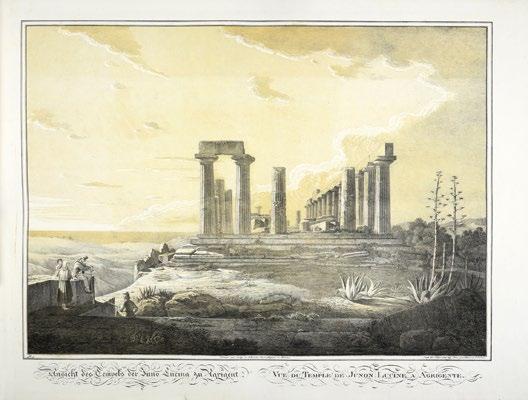

45 Shapero Rare Books
16. [gIReNNeRIe, Raoul Ange Édouard de la] GIRIN, pseud. Moeurs Moscovites. Arnauld de Vresse, Paris, [n.d. circa 1865].
BRIghT C aRIC aTuReS, full Of INveNTION, KepT IN TheIR puBlISheR’S pRINTed BOaRdS.
RaRely fOuNd COmpleTe We could trace only one example at auction in the past 35 years, more than 10 years ago. Worldcat locates only one copy - in the Bavarian State Library; no copies found in the two main Russian libraries (RGB and RNB) and none in France (not in the BNF; one in Roubaix but dated 1880).
All works by the French artist Girennerie (born c.1830), a hussar officer and pupil of Pils and Armand-Dumaresq, are uncommon.
The “war of caricatures” between the Russian Empire and European powers did not stop with the end of the Crimean War (1853-56). English and French artists continued to portray Russia as a backward country ruled by corrupted officials, and populated with superstitious people, dancing bears and wild wolves.
A rare and curious item giving an insight into European propaganda - in fresh condition and with interesting provenance.
Provenance: Boris Berezovskiy (1946-2013, Russian businessman and politician).
Landscape folio (25.7 x 34 cm), hand-coloured lithographed title, 18 hand-coloured lithographed plates. Original green pictorial boards lettered in gilt on upper cover; spine worn, corners slightly bumped. Thieme-B. XIV, 178.
£4,750 [ref: 91602]
46 Shapero Rare Books


47 Shapero Rare Books
17. GOULD, John. The Birds of Europe.
Published by the Author, London, [1832]-37.
rare survival in the Original parts Of the first editiOn Of this celebrated wOrk.
A fine copy of Gould’s first multi-volume ornithological work and the first of his works to feature plates by Edward Lear: one of the greatest ornithological artists of all time. Lear’s contributions included the most eye-catching subjects in the book: eagles, owls, cranes, pelicans, geese, swans, and flamingos.

Lear’s plates are from bird drawings that “are certainly among the most remarkable bird drawings ever made, [for] it is evident that Lear endowed them with some measure of his own whimsy and intelligence, his energetic curiosity, his self-conscious clumsiness and his unselfconscious charm” (Hyman).
“Lear’s participation transformed the work of Mrs. Gould.... [H]e propelled her limited sense of perspective into the third dimension. He encouraged movement, vigor, and a sense of character in her birds; he instilled an idea of composition in which the subject related to its background instead of perching in midair like a cardboard cutout. He introduced a sense of subtlety and freedom into her drawings where previously she had only mimicked the technique used in etching or engraving. There is no doubt that Edward Lear was the first person to understand the art of lithography and to use it to its fullest potential. It was a legacy that made the works of Gould into a success and took them into the forefront of nineteenth-century illustration” (Tree).
22 original parts, folio. 448 lithographic plates (complete) by and after Elizabeth & John Gould and Edward Lear, all with fine bright original hand colouring, one plate (Puffin also in duplicate) with repaired closed tear affecting image, occasional spotting and creasing, dedication, preface, introduction, title pages, list of plates and list of subscribers bound in part 22, original publisher’s printed boards with part numbers added in contemporary manuscript, well preserved in six fine green morocco-backed solander boxes, spines richly gilt in compartments, raised bands, a fine set of a rare survival. Anker 169; Fine Bird Books, p.77; Nissen IVB 371; Sauer 2; Wood, p.364; Zimmer, p.251.
£95,000 [ref: 92010]
48 Shapero Rare Books

18. hOdgeS, William. Select Views in India, drawn on the Spot, in the Years 1780, 1781, 1782, and 1783, and Executed in Aqua Tinta.
William Hodges, London, [1785-1788].
first editiOn a landmark in tOpOgraphical bOOk illustratiOn, the first Of the great view bOOks Of india
‘Probably but not certainly’ (Abbey) the first issue with fewer text leaves than the later issue, and without the publisher’s imprint and uncoloured.
Contains the first substantial series of aquatint views of India, including the first printed depiction of the Taj Mahal (shown in the background of plate 16 ‘A View of the Fort of Agra’).
Following the increasing affluence of life in the cities as the Presidencies of Madras, Bombay, and Bengal developed during the eighteenth century, British portrait artists were attracted to India by the prospect of patronage, amongst these were John Zoffany, Tilly Kettle, and Ozias Humphrey.
It was not until 1780, however, that the first person to practice professionally as a landscape artist came to India, namely William Hodges, formerly the official artist on Captain Cook’s second voyage to the South Seas, and a pupil of Richard Wilson. Hodgers disembarked at Madras and made his way to Calcutta in 1781 where he met Warren Hastings who became his life-long friend and patron.
Many public buildings and mansions were under construction in Calcutta at this time and the city made an immediate impression upon him: “The vessel has no sooner gained one other reach of the river than the whole city of Calcutta burst upon the eye”. He likened the various colonnades of the city to Grecian temples and was completely captivated by Indian, as opposed to British, architecture. In the same year Hodges made three journeys up-country, recording his observations. Arriving back in London in 1784, he singlehandedly produced the prints for this publication from his drawings and paintings. The aquatint technique, then in its infancy, was used with exceptional fluency by Hodges to preserve the atmospheric quality of his original sketches.
The series was published inn 12 parts between 1785 and 1788, with a description of each scene in English and French. The first part was probably published by Hodges, the next six parts were published by John Wells until August 1787, when another publisher, J. Grives, took over. Except for a view of Tanjore in the south, all the prints are based on drawings made during Hodges northern tours.
Provenance: Hugh Lupus, 1st Duke of Westminster (1825-1899; bookplate).
Folio (56.5 x 44cm). Single-volume issue with title-page, dedication and text in French and English, 48 aquatint plates, printed in bistre, by and after Hodges; lacking list of plates in vol.I, title and list of plates in vol.II and the map of the River Ganges, Jumna, Goomty & Gogra, some plates with marginal waterstaining, scattered light spotting. Contemporary tree calf, rebacked, corners and edges reapired, an attractive example. Abbey Travel 416; Tooley 263.
£30,000 [ref: 92244]
50 Shapero Rare Books
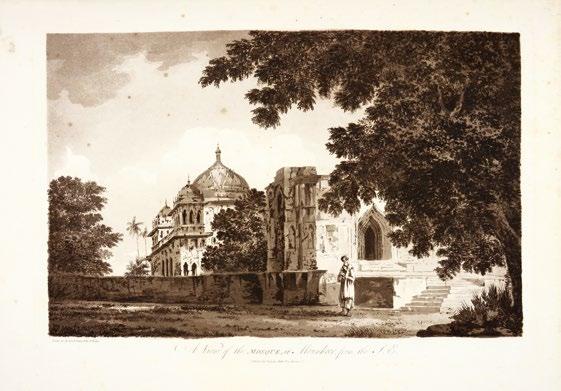

51 Shapero Rare Books
19. leOpOld, Joseph Friedrich. [Twelve months of the year].
In Augspurg verlegt und zu finden beij Jos Fried: Leopold, auf del obst Marchi, [c. 1710].
the cOmplete set, a spectacular example heightened with gOld.
Joseph Friedrich Leopold (1668-1726) was a publisher, engraver, printseller and bookseller in Augsburg, taking over the publishing firm of J.U. Kraus in 1719. His son, Johann Christian Leopold (1699-1755), succeeded him.
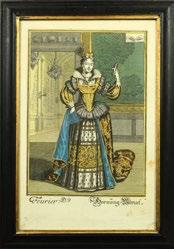
Leopold’s Twelve Months are based on etchings by Robert Bonnart (1652-1733) that were most likely made in the 1690s. At least three versions of the series are known, one with a quatrain, one without (probably that which Leopold copied), and a third by Nicolas Bonnart junior, Robert Bonnart’s nephew.
A Parisian painter and engraver, Bonnart grew up in a family of artists and art dealers. His work was divided into three main activities. First, he worked for Louis XIV, for whom he designed the “Cabinet du Roi” (the King’s cabinet) together with Frans van der Meulen, a Flemish Baroque painter specialising in battle scenes. Some of the paintings and engravings that Bonnard made for the Roi Soleil are now to be found in the Chateau de Versailles. Second, on a more personal level, Bonnart sold some of his works to private customers and sometimes worked on commission for noblemen. Finally, Bonnart helped his brothers Nicolas I and Henry II by designing many fashion engravings to be sold in their art shops on the rue Saint Jacques. These etchings were later copied and sold all over Europe, and Bonnart was soon to be seen as one of the masters of the “dessin de mode” (fashion drawings).
Etchings with original hand colouring and gold highlights, with titles in French and a German descriptive title of the image, numbered 1-12 in bottom right corners; occasional light foxing, plates 11 & 12 (November and December) bottom right corners a bit damaged and plate 9 (September) toned. Framed and glazed, overall size: 39 by 27.7cm.
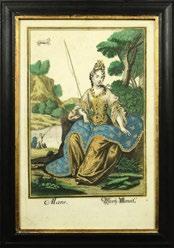
£8,500 [ref: 90518]

52 Shapero Rare Books

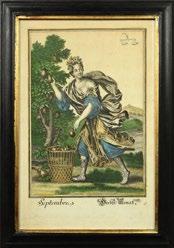
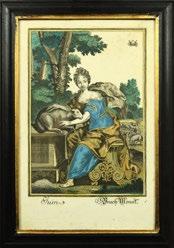

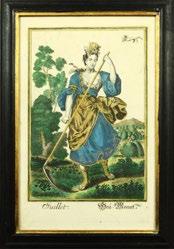

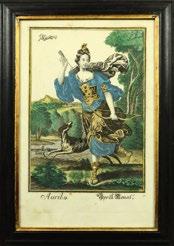
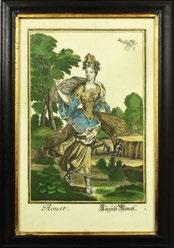

53 Shapero Rare Books
20. lINaTI, Claudio. Costumes et moeurs de Mexique. Engelman, Graf Coindet & Cie., London, 1830.
fIRST eNglISh edITION Of The fIRST lIThOgRaph plaTe BOOK ON mexICO. An edition of this work was published in Brussels in 1828. The English edition omits the sixteen plates of religious costumes.
These outstanding lithographs are an important source on Mexican life and manners during the first decades of the nineteenth century. Included is a magnificent illustration of a bold Apache chief with numerous colourful tattoos on his chest and arms, armed with decorated shield and lance, galloping on horseback, with legend below: Cacique Apache des bords du Rio Colorado dans la Californie.
“The most popular of the [illustrated] albums [of Latin America] were those containing landscape views and costumbritas scenes, and it was in those areas that the ‘confrontación de miradas’ between European and Latin American artists can best be examined.... Linati’s own Costumes civils, militaires et réligieux du Mexique is one of the most interesting and liveliest of the more specialized albums. In spite of its title, it is considerably more than a book of picturesque costumes of trade, professions, and regions (though it contains these, too), for it includes historical figures, each carefully commented on and chosen out of a clear commitment to Mexican ideals of independence and reform. The first plate depicts Montezuma, and Hidalgo, Morelos, and Fray Gregorio are all included” (Dawn Ades, Guy Brett, Stanton Loomis Catlin & Rosemary O’Neill, Art in Latin America: The Modern Era, 1820-1980, Yale University Press, 1989, pp. 73-74).
First English edition. 4to (27.5 x 21.5cm), 68pp., 33 handcoloured lithographed costume plates on Whatman paper, all plates signed in the stone by Linati, contemporary calf gilt neatly rebacked, binding slightly scuffed, plate 32 with old marginal tear repaired and laid down,else in excellent condition. Colas 1872. Hiler, Bibliography of Costume, p. 545. Lipperheide 1622. Mathes, Mexico on Stone, pp. 8-14: “Immediately became the basis for many other illustrations of Mexico, as well as the principal source for information on the region since Humboldt.” Museo Nacional de Arte, Nación de imágenes: La Litografía mexicana del Siglo XIX, pp. 56-69, 163-170, 340-341. Palau 138502.
£6,500 [ref: 92944]
54 Shapero Rare Books

21. meyeR, J[ohann] J[akob]. Mahlerische Reise auf der neuen Kunststrasse über das Stilfserjoch durch das Veltlin längs dem Comersee nach Mayland.
Meyer, Zurich, 1831.
fine, highly finished aquatint views alOng the newly built rOad Over the stelviO
Johann Jakob Meyer (1749–1829) began his artistic training at the age of fourteen under Heinrich Füssli and later learnt etching and aquatint techniques in the studio of the printmaker Franz Hegi. As a young man, he regularly explored the countryside, painting and sketching before nature. He continued his training in 1811, working with the well-known family of artists named Lory in Neuenburg. In 1823, he produced a series of drawings for a travel guide titled Die Bergstrassen durch den Canton Graubünden with texts by Johann Gottfried Ebel (see next item).
Meyer travelled widely in the Alps. He climbed the Calanda near Chur in 1827 and crossed the Stelvio Pass in the eastern Alps in 1829 on the newly constructed road over the pass. He recorded his impressions of the pass in a series of watercolours which he published as aquatints in the present work.
Meyer’s landscapes were highly sought after in his lifetime. Friedrich Wilhelm III of Prussia, his son Crown Prince Friedrich Wilhelm and Tsar Nicholas of Russia were all collectors and patrons of his work.
Provenance: Fürstliche Hofbibliothek Donaueschingen (stamp to title).
First edition. Landscape folio (29.5 x 22 cm), title with hand-coloured aquatint vignette, 36 fine handcoloured aquatint plates, folding hand-coloured map, loose in original grey wrappers (titled in French Voyage Pittoresque sur la nouvelle route depuis Glurns en Tyrol par le Col de Stilts (Passo di Stelvio)...), modern morocco-backed box, a fine example.
£15,000 [ref: 92951]
56 Shapero Rare Books
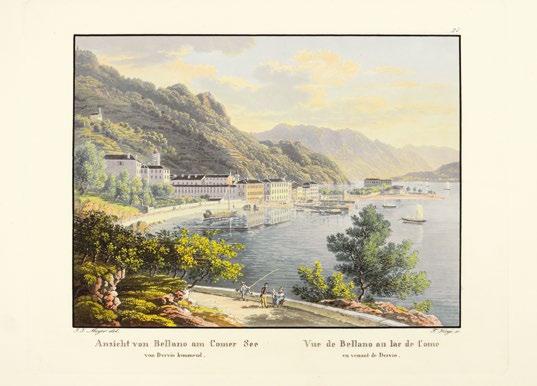

57 Shapero Rare Books
22. meyeR, J[ohann] J[akob]; J[ohann] G[ottfried] Ebel. Die Bergstrassen durch den Canton Graubünden nach dem Langen und Comer-See.
Meyer, Zürich, 1826.
a finely bOund cOpy Of the first editiOn Of the rare deluxe editiOn with additiOnal cOlOuring. One Of the mOst beautiful wOrks Of the early nineteenth century with swiss views, depicting the picturesque valleys and landscapes Of graubunden, lagO di cOmO and lagO maggiOre
The issuing of the work was prompted by the completion in 1823 of two new roads (shown on the map at the back) passing over the Alps between Switzerland and Italy, one by the San Bernardino pass, the other by the Splugenberg.
Johann Jakob Meyer (1749–1829) began his artistic training at the age of fourteen under Heinrich Füssli and later learnt etching and aquatint techniques in the studio of the printmaker Franz Hegi. As a young man, he regularly explored the countryside, painting and sketching before nature. He continued his training in 1811, working with the well-known family of artists named Lory in Neuenburg. He produced the drawings for the present work in 1823.
Meyer travelled widely in the Alps. He climbed the Calanda near Chur in 1827 and crossed the Stelvio Pass in the eastern Alps in 1829 on the newly constructed road over the pass. He recorded his impressions of the pass in a series of watercolours which he published as aquatints in Mahlerische Reise auf der neuen Kunststrasse über das Stilfserjoch (see previous item).
Meyer’s landscapes were highly sought after in his lifetime. Friedrich Wilhelm III of Prussia, his son Crown Prince Friedrich Wilhelm and Tsar Nicolas of Russia were all collectors and patrons of his work.
Johann Gottfried Ebel (1764-1830) was born at Zullichau (Prussia). He became a medical man, visited Switzerland for the first time in 1790, and became so enamoured of it that he spent three years exploring the country and collecting all kinds of information relating to it. He was the author of the first real guidebook to Switzerland.
Provenance: Fürstliche Hofbibliothek Donaueschingen (stamp to title).
First edition, deluxe issue. Landscape 4to., Engraved title page with aquatint vignette, five lithographic key plates, one small key plate for plate 7b (none for 25b, as is usual), folding hand-colored map by H. Keller, and 32 fine hand-coloured plates after Meyer, numbered 1-30 and 7b and 25b, all with tissue guards. Contemporary red morocco, gilt borders, a fine clean copy.
Lonchamp 892 u. 897; Wäber I, 332
£20,000 [ref: 92952]
58 Shapero Rare Books
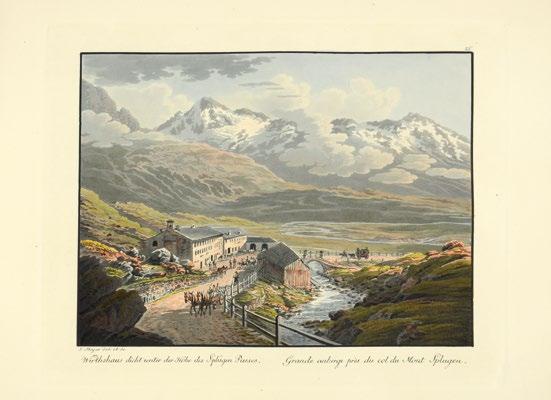
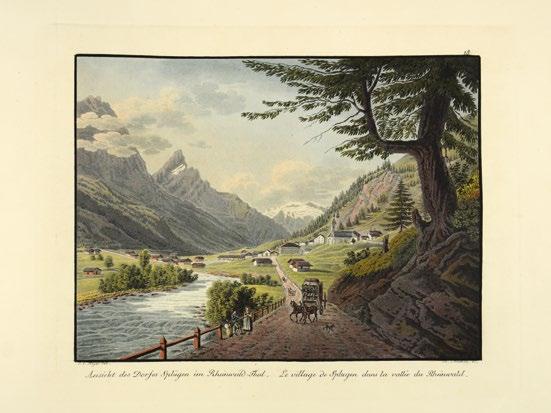
59 Shapero Rare Books
23. mIRO, Joan (artist) and Xavier DOMINGO. El Inocente. Paris, 1974.
BeauTIful example Of The BeST papeR Of ThIS WORK: WITh 11 COlOuRed plaTeS INSTead Of The NORmal 3 – all SIgNed By mIRO; ONe Of ONly 15 COpIeS ON japON NaCRé, ThIS ONe NumBeR 8. The total print run was limited to 195.


The work is made of six poems, translated into French by Didier Coste, plus another, unnumbered poem that follows the title page. Illustrating these poems are eleven gorgeous etchings made by the famous Spanish painter, sculptor and ceramist Joan Miro (1893-1983), who gained international acclaim thanks to his abstract, colourful paintings that have been interpreted as Surrealism.
Domingo’s beautiful, often simple and sharp verses are a powerful reflection on war and peace, political power, justice and innocence. Just like Miro aimed to upset the visual elements of established painting, Domingo’s texts broke with the traditional rules of poetry. Hence a perfect collaboration between the two artists: Domingo’s seemingly naive yet striking writing style is here beautifully illustrated by Miro’s apparently simplistic yet incredibly powerful and lively etchings.
Born in Catalonia in 1929, Xavier Domingo lived in Paris between 1956 and 1976 where he worked for the France Press Agency. After his return to Spain he became a correspondent for Cambio 16. Later on in his career, in the 1980s, he started working at El Observador in Barcelona. On top of publishing his writings in Spain - notably works on gastronomy -, he ran a publishing house and had several novels published in France such as Villa Milo (1961), Le rêve de la raison (1984) and La veuve andalouse (1972), as well as essays and poems.
With eleven etchings with aquatint, seven printed in colours, ten signed and numbered 8/15 in pencil, one unsigned serving as the slip-case cover, with title-page, text and justification, signed by the author in pencil, numbered 8, on japon nacre paper, the full sheets, loose in the original brown paper covered boards, and silk slipcase, overall size 35.5 x 27 cm (14 x 10 5/8 in).
C. 184.
£27,500 [ref: 91933]
60 Shapero Rare Books
a
BeauTIful mIRO CReaTION, ON The BeST papeR

61 Shapero Rare Books
24. mORNay. A Picture of St. Petersburg, represented in a Collection of Twenty interesting Views of the City, the Sledges, and the People. Taken on the Spot, at the twelve different Months of the Year: and accompanied with an Historical and Descriptive Account.
Howlett and Brimmer, and Dove for Edward Orme, London, 1815.

first editiOn Of One Of the best illustrated bOOks On saint-petersburg, fully handcoloured. The twelve lovely views, taken at each month of the year, include the Imperial Bank, the Marble Palace, the Square with the Grand Theatre, The Imperial Palace, and the Great Bridge. Unique to this work are the eight plates of Russian carriages and sleighs and their occupants, all dressed in contemporary costume and boldly coloured.
Provenance: Royal Institution of Great Britain (blind stamp to title); Boris Berezovskiy (1946-2013, Russian businessman and politician).
Folio (48 x 33.2 cm). Frontispiece, title, 34 pp., 20 hand-coloured aquatint plates engraved by Clark and Dubourgh after Mornay, captions in English and French, text in English, 12 plates watermarked 1811, 1 plate - 1814; final text leaf misbound, torn across and repaired, plates slightly soiled, first 4 plates with short tears in margin (one just touching the image). Contemporary green boards, paper label to spine. Abbey Travel 226; Martin Hardie, 138; Prideaux 345; Tooley (1954), 355.
£16,000 [ref: 91965]
62 Shapero Rare Books


63 Shapero Rare Books
25.
[NAPOLEONIC WARS]
- ADAM, Albert. Voyage pittoresque et militaire de Willenberg en Prusse jusqu’à Moscou fait en 1812.
Hermann and Barth, Munic [sic], 1827-28 [but -32].
Extensive artistic account of Napoleon’s Russian campaign, complete with text and subscriptors’ list. “Publication of first quality extremely important for the history of the year 1812” (Solovev).
Albert Adam, son of artist Victor Adam, followed the Prince Eugene recording views and events of the disastrous 1812 campaign. After the death of the Prince, he published his drawings in the present volume, sometimes as fully accomplished lithographs, sometimes as line drawings only. The plates show city or landscape views together with studies of soldiers and battle views, in particular in Smolensk, near Borodino and in Moscow - where the account ends.
This copy is complete with the letterpress title and explanatory text to each plate, taken from Adam’s own diary and from one of the main sources at the time, Labaume’s ‘Campaign in Russia’. It also includes the 3-page subscribers list, mainly filled by German aristocracy.
Two parts in 1 volume, large folio.Title lithographed by Mettenleiter, letterpress title, [2] preface, [3] pp. subscribers, 3 lithographed portraits by D. Engelmann, 98 lithographed plates by Adam, including one after C. de Heideck, [47] pp., [2] chronological table; spotting and browning, sometimes heavier, marginal tear to one plate. Contemporary calf over marbled boards, spine with raised bands richly decorated in gilt; corners slightly bumped, lower edge of spine slightly chipped. Solovev Kat.105, 272 (130 rub.!).
£7,500 [ref: 89817]
64 Shapero Rare Books
pICTORIal ReCORd Of NapOleON’S RuSSIaN C ampaIgN

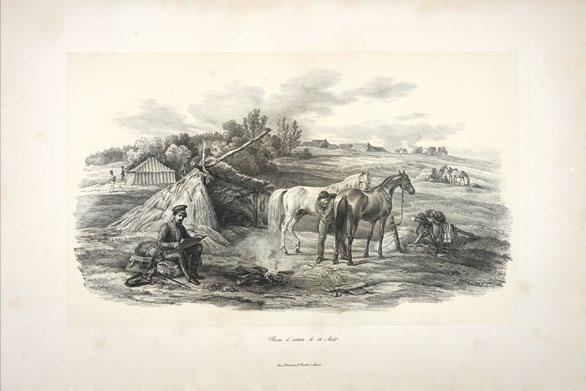
65 Shapero Rare Books
26. NaTTeS, John Claude. Versailles, Paris, and St Denis; or a series of views from drawings made on the spot... illustrative of the capital of France and the surrounding places. With an historical and descriptive account.
For W. Miller, London, [1810].
an Outstanding series Of views Of versailles and paris by One Of the fOremOst drawing masters Of his day. The work is characterized by many unusual subjects and interesting perspectives, and provides a fine record of Paris in the aftermath of the Revolution. It was produced in quite a small edition and has always been scarce and sought after.
The Versailles plates form a beautiful set, not only of the park of Versailles, the Trianon, the famous machine at Marly, which pumped water for the fountains of Versailles, but also for the environs including St. Cloud. Many of the Parisian views show the influence of Piranesi in the choice of angles and also Nattes was taken with the bridges; 8 of the views are of bridges and a further 7 are scenes drawn from beneath them.
John Claude Nattes (1765?-1839) was a topographical draughtsman and watercolour painter who travelled widely in England and France and a founder member of the Society of Painters in Watercolours. He trained as a pupil of Hugh Primrose Deane, the Irish landscape-painter. He evidently had a great affection for France in general and Paris in particular as at the end of 1822 he left England and almost certainly settled in France, where a number of collections of his drawings are located; his last known address was in St Germain. The main collections of his work are in the British Museum, the Victoria and Albert Museum, and the Guildhall Library, London; the print room at Windsor Castle; the Bodleian Library, Oxford; and the National Library of Scotland.
“Some of the finest aquatint plates in existence are those done from the dr awings of John Claude Nattes... The Views of Versailles, Paris, St Denis are well known as fine and attractive” (Prideaux, p. 274).
Published during the time of the Napoleonic War, very few English people would have travelled in France at this time. This probably accounts for the small edition and scarcity of the work.
First edition. folio (48.5 x 35 cm. approx.), [iv], 86 pp, including title page and list of plates. Forty fine handcoloured aquatint plates, by Hill after Nattes (except for plate 29, by Cartwright after Nattes), plates on Whatman paper watermarked 1808, fine modern period style black straight-grained morocco richly gilt, first four leaves of text with neat restoration to fore-edge, 2 leaves with short tears repaired, an excellent example. Abbey, Travel, 103. Prideaux p. 346. Tooley 342 (text in French).
£13,500 [ref: 92937]
66 Shapero Rare Books
SupeRB ReCORd Of veRSaIlleS aNd paRIS

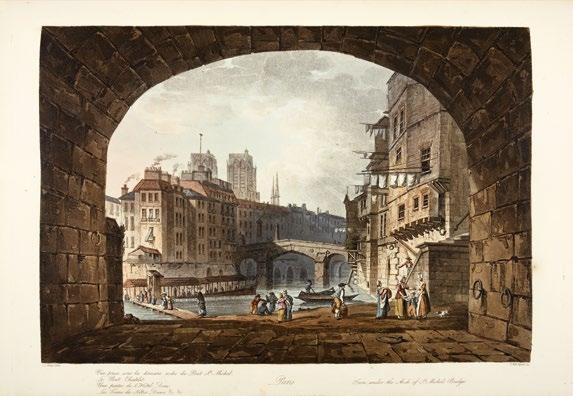
67 Shapero Rare Books

item 27 - The Kinnaird Sketchbook.
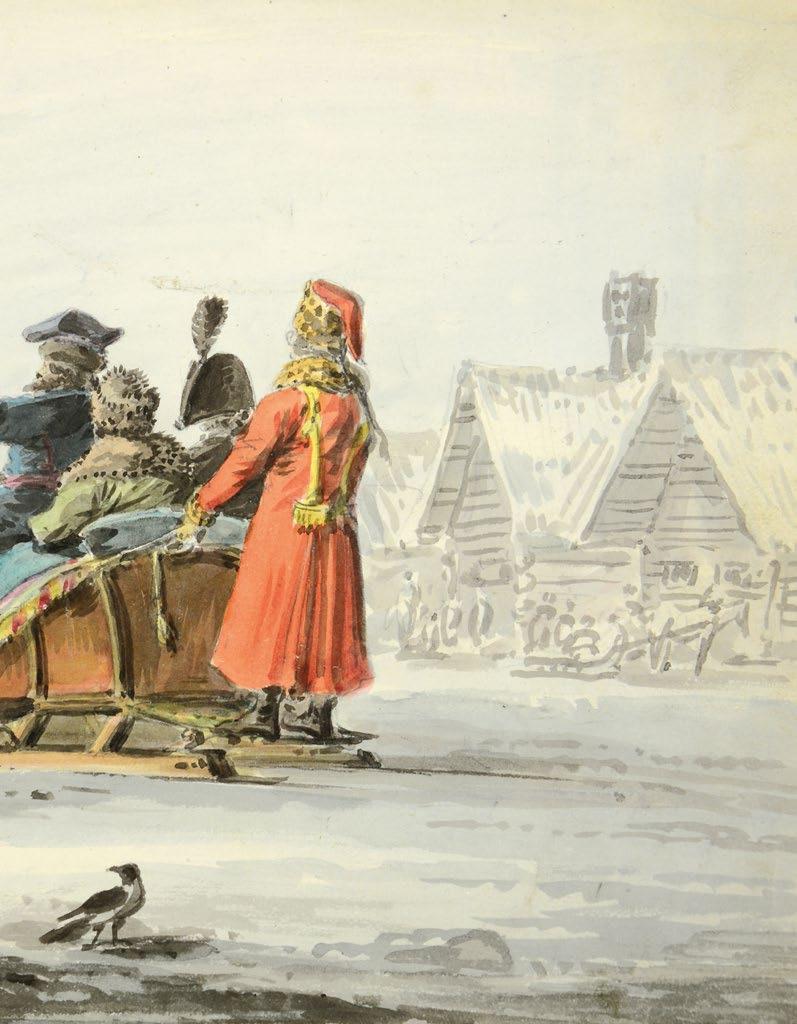
exCepTIONal RuSSIaN SKeTChBOOK
27. ORlOWSKI [ORLOVSKIY], Alexandre. The Kinnaird Sketchbook. [With:] The Costume of the Russian Army.
Russian Army: Orme, London, 1807.
ORlOWSKI’S SKeTChBOOK Of ORIgINal dRaWINgS: a uNIQue ITem WhICh pROvIded maTeRIal fOR
TWO CONTempORaRy puBlICaTIONS aNd WaS KepT IN The Same famIly fOR OveR TWO huNdRed yeaRS. a rare survival which bears witness tO the skilful art Of the yOung OrlOwski, a talent which made his fame bOth in russia and his fatherland, pOland
The title-pages of the uncommon works Russian Army (London, 1807) and Russian Cries (London, 1809) both state that the engravings were taken from a Collection of Drawings Made on the Spot, and now in the Possession of The Right Honourable The Earl of “Kinnaird”. This ‘collection of drawings’ constitutes the present sketchbook, as Basil Gray (1904-89), art historian and Keeper of Oriental Antiquities at the British Museum, confirmed in his letter to Earl Kinnaird in 1935. This letter accompanies the sketchbook, as well as a title page from Russian Cries and a complete copy of Russian Army, with the same provenance.
Beside the 18 sketches published, the album contains 10 further sketches in a similar vein. These do not appear to have ever been published.
The entire album is devoted to Russian costumes, typically soldiers and streetvendors,sometimes with sledges, set against fully worked backgrounds. It was made shortly after Orlowski’s arrival in Saint-Petersburg, possibly during his early years of travels through the Russian empire and Western Europe. Indeed, after having enjoyed prestigious Polish patrons such as Prince Józef Poniatowski and Izabela Czartoryska, who founded Poland’s first museum in Krakow, the talented Orlowski (1777-1832) moved to the Russian capital, where his drawings were well received at court. He then travelled extensively,all the time sketching, before receiving an official position from the Russian government in 1819.
Provenance: Kinnaird bookplate of the family of the Nile explorer James Bruce.
Landscape 4to., 28 watercolour and 2 pencil sketches (incl. perhaps a self-portrait), pencil ms. annotations to 8 sketches (possibly by the artist), 2 pp A.L.s. from Basil Gray to Lord Kinnaird loosely inserted, title-page from a copy of Russian cries folded and loosely inserted; one sketch loose and torn, light occasional staining. Full contemporary brown sheep; slightly rubbed.
The Costume of the Russian Army, folio, with hand-coloured engraved vignette of publisher’s wrapper cut out and laid on colour paper, stipple-engraved portrait by Godby after Jean Pichon, dated 1806, printed in colours and finished by hand, title-page, dedication, 8 hand-coloured plates with tissue guards; occasional light browning and finger marks. Later cloth, upper cover lettered in gilt.
£35,000 [ref: 92133]
70 Shapero Rare Books
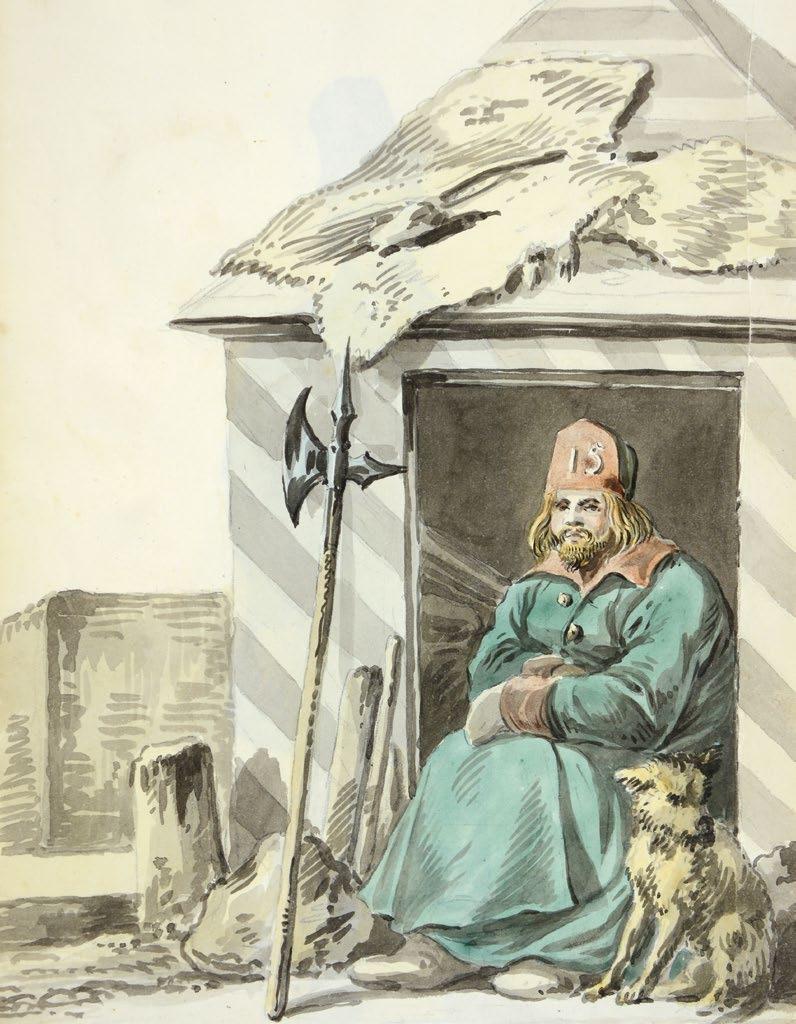
28. [OTTOMAN EMPIRE]. Album of Watercolours of Turkish Costumes. ca. 1825-30.
a BeauTIful alBum WITh 90 WaTeRCOlOuRS Of TuRKISh COSTumeS daTINg fROm The ReIgN Of SulTaN mahmud II, BeTWeeN 1808 aNd 1839.
As often with albums of Turkish costumes, the present one follows a threefold structure. In the first, largest category appear the Sultan and the main members and officers of his court (Mufti, Serasker-Pacha, Capidji-Bachi, Chief of the Black Eunuchs, Turban Carrier, etc.). In the second category we can see people with different roles in society (Dervish-Mevlevi - whirling dervish, water carrier, sorbet seller, caviar seller, etc.), and in the third, the various nations that composed the Ottoman Empire, including women (Albanese, Muslim from Mecca, Syrian, Vlach, Georgian, Greek, newly wed Armenian, Jewish woman, etc.)
Each character is cut out at the centre of the page, standing on a small shaded ovoid section. Their title are written in pen underneath, with a French translation of their function if necessary.
This collection of watercolours can be linked with a 69-plate album dating from the end of the 18th century and kept at the Department of Etchings and Photography of the Bibliothèque nationale de France [Od-23-4]. Several drawings seem directly based on it, however this is not the only source that the present album draws from.
While taking up previous compositions, this set has been updated, as shown by the presence of a drawing of the sultan “in his new costume” - which probably represents Mahmud II. Besides, several soldiers of the Janissary corps are featured, while they were swiftly abolished in 1826.
A fine fresh example, with an unusually large number of watercolours.
Landscape 8vo (13.5 x 20 cm) with 90 watercolours. Contemporary green straight-grained sheep, flat spine with gilt rules; rubbed, corners bumped, joints starting. Commercial label at the head of inside cover: “Au Grand Livre. Boullanger fils, Papetier, Boulevard Poissonnière, N° 23 à Paris”.
£16,500 [ref: 92201]
72 Shapero Rare Books
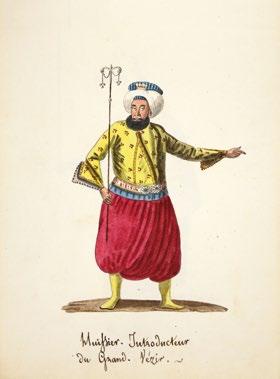


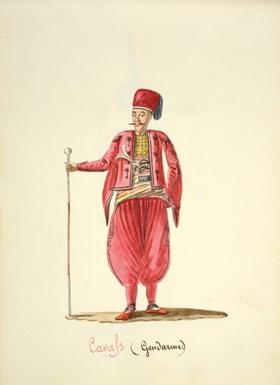
73 Shapero Rare Books
29. paxTON, Joseph. Magazine of botany and register of flowering plants. London, 1834-1849.
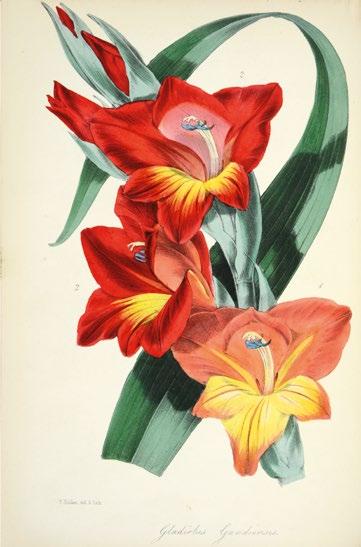
Paxton (1803-1865), was head gardener to the Duke of Devonshire at his great Chatsworth estate, which he made one of the most famous gardens of Europe. The plants depicted include many exotic species newly introduced to England. His interest in such species went hand-in-hand with his interest in greenhouses and hothouses which allowed these plants to flourish.
A complete set such as this is scarce. The drawings on which the plates are based are by F.W. Smith, S. Holden, C.J. Fleming, and O. Jewitt.
First edition. 16 Volumes, 8vo, 717 engraved plates (716 hand-coloured) complete, contemporary black half morocco gilt, a fine set.
£8,500 [ref: 92253]
74 Shapero Rare Books
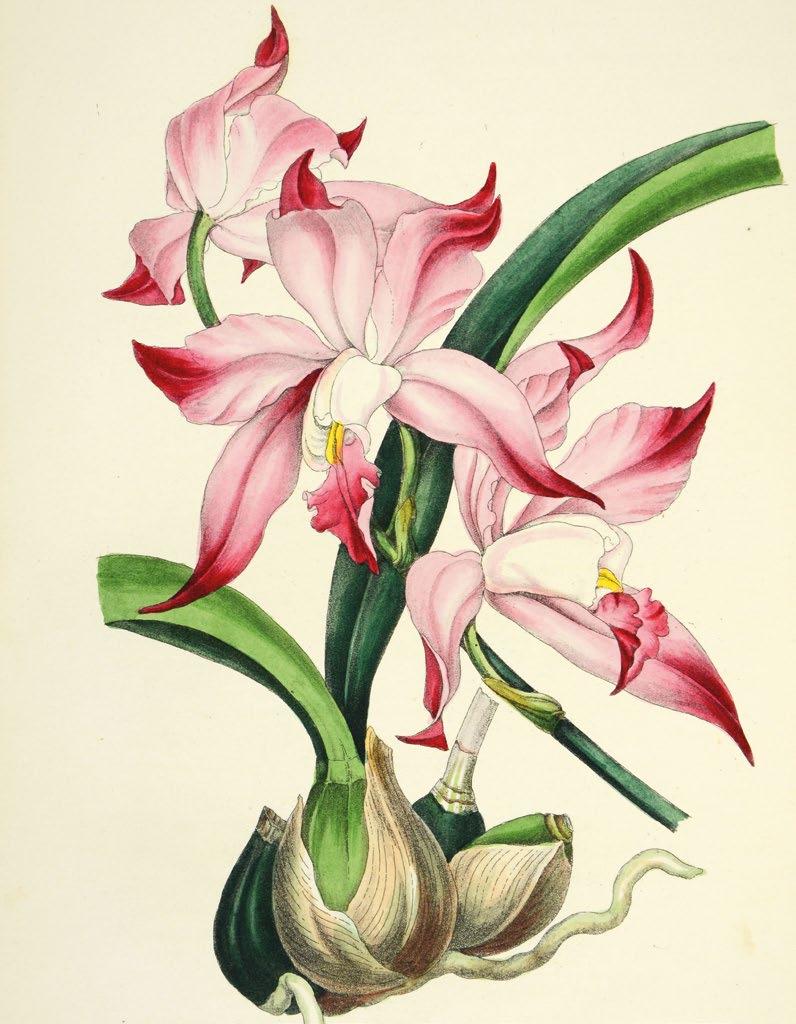
30. PIRANESI,
Giovanni Battista. Le Antichità Romane.
Stamperia di Angelo Rotili nel Palazzo de’ Massimi. Bouchard & Gavier, Rome, 1756.
pIRaNeSI’S
This work, which required eight years of careful study and excavation by Piranesi, established his reputation as the leading protagonist of Roman archaeology when it first appeared in 1756. His aim, as with all his archeological publications, was both to record the vanishing past for scholars and to inspire contemporary designers to emulate the achievements of ancient Rome.
Volume I explains the urban structure of ancient Rome in terms of its walls, defences and aqueducts as well as its public monuments. Volumes II - III include the plans of the Camera Sepolcrali, and are devoted to the extensive remains of sepulchres around Rome. Volume IV concentrates on the heroic feats of Roman engineering in the form of bridges and monumental structures such as the Curia Hostilia, the substructure of the Temple of Claudius, Hadrian’s mausoleum (the Castel Sant’Angelo), and the Theatre of Marcellus. As John Wilton-Ely notes, the work includes plates by or after other artists, chiefly in volumes II and III.
‘The double-page engraved titles of volumes 2 and 3 of Piranesi’s Le Antichità Romane display the artist as the most visionary of classical archaeologists. Imaginative and fascinating in all their myriad detail, these two ‘restored’ views of the great Roman Appian Way have all the overwhelming effect of the modern canyons of New York City, but embellished with classical finials and endless ornament’. (Princeton University, In Search of Art: The English Grand Tour exhibition).
‘After two hundred years, the work still remains the vastest picture book of buildings and antiquities in Rome. Almost half the engravings record things that have since vanished or been further damaged. It is the first book that attempted to reassemble objects that had been found and then scattered. The big plate of the Roman water system was the first painstaking reconstruction of far flung and complicated ruins, and alone cost him six months of drawing, digging and measuring. This book also went farther than previous attempts to interpret ancient remains in the light of ancient texts, and especially in the light of Vitruvius’ description of Roman engineering practice’. (A. Hyatt Mayor, Piranesi, pg. 12).
With the 2 letters to Charlemont Avviso al publico dated 25 August 1756 and A Milord Febbraio 1757.
This copy retains the rare Imprimatur leaf (†2) bound after the Prefazione with the list of published titles by Piranesi to the verso; the Imprimatur is dated ‘25 Gennaro 1756’. Piranesi’s publications listed on the verso of the leaf (and available at the same booksellers ‘Bouchard e Gravier’) consist of the Vedute di Roma, the Prospettive... con varii grotteschi, the Carceri, the Vedute di Antichita Romane and the Trofei.
Provenance: Hugh Lupus, 1st Duke of Westminster (1825-1899; bookplate).
First Edition. 4 volumes. Folio. (53 x 40.5 cm). Vol. I: pp. iv (‘Prefazione’ and ‘Imprimatur’ leaf dated ‘25 Gennaro 1756’ with list of Piranesi’s publications verso), pp.(iv) Avviso al publico. 25 Augusto 1756. pp.(ii) Milord. Febbraio 1757.pp.40, pp. xi (‘Spiegazione’ and ‘Osservazioni’), pp.iii (‘Indice, O Sia Spiegazione’), pp.iv (‘Indice’), pp.iii (‘Indice’), pp.(ii) (‘Repertorio’).
76 Shapero Rare Books
Nella
mOST ImpORTaNT WORK IN a veRy eaRly STaTe, WITh duCal pROveNaNCe
Engraved frontispiece portrait of Piranesi by Polanzani, printed title, engraved double-page dedication plate with text ‘Utilitati Publicae’ (second state after the removal of

‘Lord Charlemont’), Piranesi’s text and 44 engraved plates plus 1 map, of which 5 are double-page, 1 large folding plate on two sheets, 2 folding plates on 1 sheet and 30 single page plates with two images;
Vol. II: engraved title, engraved double-page frontispiece and engraved list of subjects and 60 engraved plates, numbered I - LXIII (including title, frontispiece and list of subjects), of which 44 are double-page and one large double-page folding plate on 2 sheets;
Vol. III: engraved title and engraved double-page frontispiece and 52 plates, numbered I - LIV (including title and frontispiece), of which 42 are double-page and one large double-page folding plate on 2 sheets (four plates are by Girolamo Rossi and one by an anonymous artist);
Vol. IV: engraved title, engraved double-page frontispiece and engraved list of subjects and 57 plates. Sheet size (double-page): c.725 x 520 mm (or the reverse). Watermarks examined include, the shiled with sword and fleur-de-lys (Robison 61) a fleur-de-lys with initials (Robison 20 / 21), a fleur-de-lys within a single circle (Robison 18 / 19) however the majority of those present appear to be the fleur-de-lys within a double circle (Robison 33 / 35).
Full contemporary polished calf, rebacked, boards with triple-ruled borders and floral corner pieces in gilt, banded spines with gilt tooling and black leather label with gilt title in nine compartments, turn-ins tooled in gilt, marbled endpapers and edges. Repairs to edges and corners. An excellent example. Hind pp. 83 - 84; Wilton-Ely pp. 327 - 582; Millard 88.
£95,000 [ref: 92728]
78 Shapero Rare Books
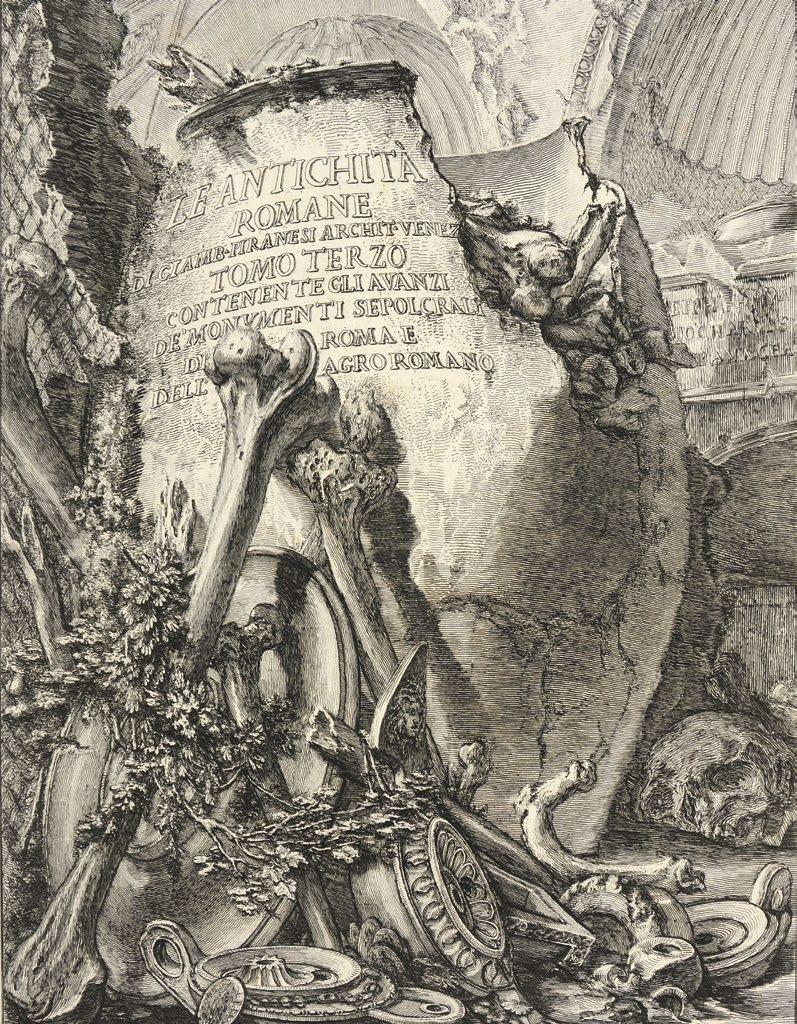

80 Shapero Rare Books item 30 -
PIRANESI. Le Antichità Romane.

81 Shapero Rare Books
31. pIRaNESI, Giovanni Battista. Campus Martius antiquae urbis Romae. G.B. Piranesi, imprint: Piranesi, Roma, 1762.
piranesi’s engraving Of the imperial plan Of rOme, stretching Over six cOpper-plates.
This work originated in the 1750s and is dedicated to Robert Adam who befriended Piranesi during his Grand Tour visit to Rome. One of Piranesi’s most feverish fantasies, celebrating ancient Rome.Within this plan he proposes an urban and architectural landscape of the utmost complexity. Piranesi achieves this tour de force through a great variety of illustrations and employs every means of representation at his disposal including trompe l’oeil
Piranesi had earlier worked with the cartographer Giovanni Battista Nolli, the author of the plan of contemporary Rome published in 1748. The present work is an ideal companion to that map.

Provenance: Hugh Lupus, 1st Duke of Westminster (1825-1899; bookplate).
Folio (53 x 40.5 cm), engraved title, frontispiece, and 48 engraved plates, six of these joined to form one large folding plan. Text in Latin and Italian. Old repair in margin of two text leaves, contemporary calf, rebacked, neat repairs to corners and edges. Hind p. 85; Wilton-Ely D.V.; Millard 91.
£15,000 [ref: 92947]
82 Shapero Rare Books

detail
32. pIRaNeSI, Giovanni Battista. Opera Varie Opere Varie di Architettura, Prospettive, Grotteschi, Antichita.
Con Licenza dei Superiori / Si Vendono Presso l’Autore nel Palazzo del Signore Conte Toomati, Roma, 1750 [but circa 1761].
the Opere Varie, is, as its title suggests, a cOmpOsite album incOrpOrating much Of piranesi’s mOst extraOrdinary and finest wOrk.
The work opens with the Prima Parte showing imaginary adaptations and reconstructions on classical Roman themes and ranging in scope from designs for a museum of sculpture to the interiors and exteriors of palaces, views of colonnades, architectural ruins and so on. The Prima Parte, when first published in Rome in 1743, was the first of Piranesi’s collected works and included 12 plates; when forming part of the Opere Varie, Piranesi added five plates while removing another. Following these plates are the Grotteschi, four fantastic scenes published for the first time in 1750 following Piranesi’s return to Venice in the late 1740s. They are included with the Prima Parte in copies of the Opere Varie. In style and subject, the Grotteschi are very much influenced by Tiepolo and his Capricci series, however unlike the Venetian master, Piranesi’s fantasies suggest an additional coherence of meaning.
The famous imaginary prison series, the Carceri d’Invenzione, is also present here and these 16 plates, a remarkable product of the subconscious and an extraordinary demonstration of the engraver’s skill, represent the height of Piranesi’s imaginitive work. First published in 1750 when Giovanni Bouchard (Piranesi’s publisher) included 14 carceri, untitled at that time, in the earliest edition of the Opere Varie. In 1761, Piranesi reissued the group as a coherent whole, entitled the Carceri d’Invenzione and under his own name with two additional plates. While Piranesi issued no further editions of the Carceri after this time, the plates were always included with the Opere Varie and the artist continued to experiment with their aesthetic character, adjusting the tonal qualities, reworking some of the detail and experimenting with the distirbution of ink during printing.
Also present in this volume, and bound after the Prima Parte plates is the first edition of the Trofei series. The Trofei di Ottavio Augusto was intended by Piranesi to be of use to artists, painters and architects but it is of more importance as it serves as the starting point for another major area of his oeuvre, antiquity and archaeology and the achievements of the previous occupants of his adopted city: the Romans. The trophies depicted are the Trophies of Marius, removed from the fountainhead of the Acqua Giulia and placed on the Capitol in the late sixteenth century, together with several architectural fragments; Piranesi considered that the trophies had been erected by Augustus Caesar to celebrate his victory at Actium.
The album contains very good impressions of Piranesi’s etchings: this is an early Roman edition corresponding to Hind’s edition B (1761 or after), and Robison’s second edition (produced in 1761). This is an early issue of the second edition, second issue of the Opere Varie without the addition of the plate Acqua Giulia (According to Robison this plate was issued in 1761 and therefore attests to the volume being produced in early 1761). The Grotteschi are in second state (3 plates) or third state (1 plate); the Carceri are second edition, second issue with numbering in Roman numerals; the 2 plates of Ampio Magnifico are unnumbered. The Trofei di Ottavio Augusto are present in the first edition. The watermarks -where visible - conform to Robison 33, or, on occasion, Robison 35, dating to the early 1760s.
84 Shapero Rare Books
INCludeS The CarCeri
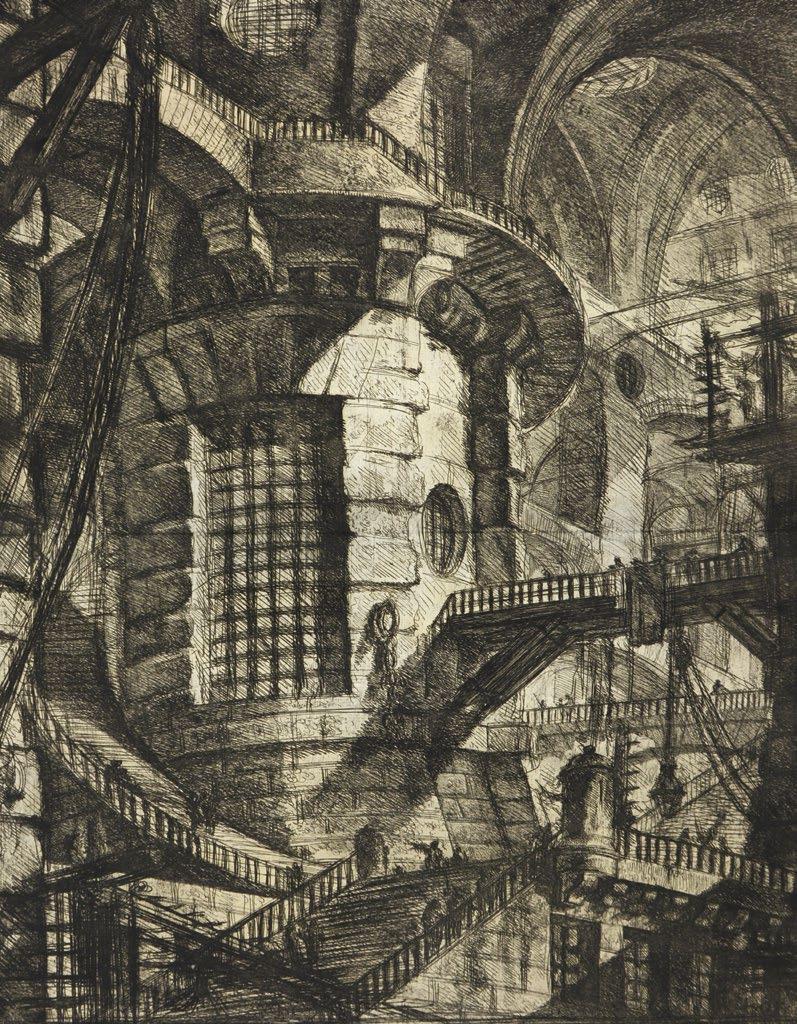
The volume seems to be a combination of Robison’s earliest and slightly later 1761 versions. There is the earliest watermark (Robison 33), the plate Sala All’Uso is in state 5 (Robison indicates that the second issue is denoted by state 7); however the Carceri are numbered with Roman numerals (the second issue) and two of the Prima Parte plates remain unnumbered.
This fine album of 53 etchings (including the two vignettes for the titles) contains the following:
PORTRAIT: Giovanni Battista Piranesi by F. Polanzani (1750).
TITLE: Printed in red and black with engraved vignette, the second version with Piranesi’s address. [Robison 28].
PRIMA PARTE: 17 plates, the second edition, second issue, dating from 1761 (as noted by Robison, nos. 17 & 18 each appearing in their 2nd states). The Camera Sepolcrale (R. 20) and Tempio Antico plates (R.19) are bound directly after the frontispiece in reverse order and without numbers, denoting early states (see Hind pg. 80). [Robison 1-3; 5-12; 15-20].
TROFEI DI OTTAVIANO AUGUSTO: 10 plates including the Vedute dell’avanzo del Castello... with Piranesi’s address, the first edition. [W.-E. 269, 271 - 278 & 169].
TWO SINGLE PLATES: Pianta di ampio magnifico Collegio: A single plate, third state (of seven). [Robison 25] & Parte di ampio magnifico Porto: A single plate, fourth state (of eight). [Robison 26]. These 2 plates are here unnumbered, for later versions of the 1761 issue these plates have numbers added. (see Hind pg. 81)
FRONTISPIECE FOR VEDUTE DI ROMA: Printed on 2 single sheets. [W.-E. 135].
GROTTESCHI : 4 plates corresponding to Robison’s second edition, second issue dated to 1761 (R. 21, 22 and 24 are second state, R. 23 is third state). [Robison 21 - 24].
CARCERI: 16 plates, the second edition, second issue. [Robison 29 - 44].
Provenance: Hugh Lupus, 1st Duke of Westminster (1825-1899; bookplate).
Large folio. (54.4 x 41.5 cm). Frontispiece portrait of Piranesi after Polanzani, printed title in red and black with engraved vignette for the Opere Varie, double-page printed title in red and black with engraved vignette for the Trofei and 50 plates, 29 double-page, all printed in black ink on thick laid paper and mounted on tabs. Sheet sizes: Single sheet: 531 x 404 mm; double sheet: c.531 x 740 mm. Full contemporary polished calf, rebacked, boards with triple-ruled borders and floral corner pieces in gilt, banded spines with gilt tooling and black leather label with gilt title in nine compartments, turn-ins tooled in gilt, marbled endpapers and edges. Repairs to edges and corners. Robison - Piranesi: Early Architectural Fantasies, A Catalogue Raisonné of the Etchings; Wilton-Ely - Giovanni Battista Piranesi: The Complete Etchings; Hind - Giovanni Battista Piranesi: A Critical Study... &c.; Millard 80 & 83.
£125,000 [ref: 92727]
86 Shapero Rare Books


item 33 - PIRANESI. Vedute di Roma.
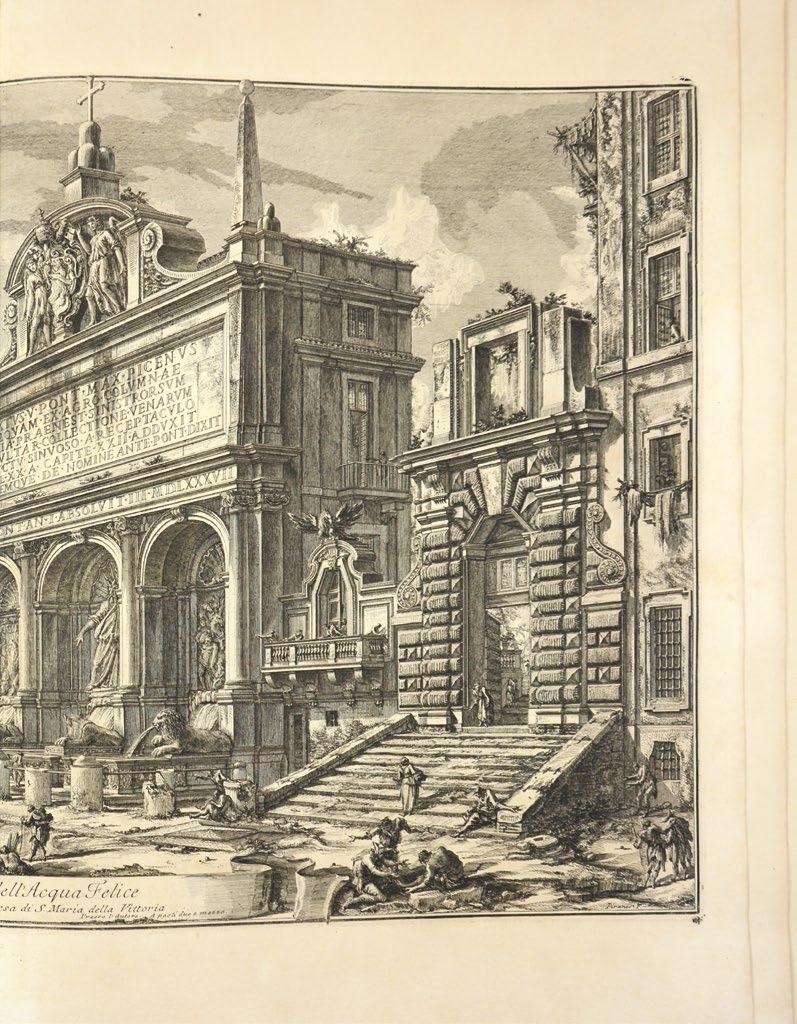
33. PIRANESI, Giovanni Battista. Vedute di Roma. G.B. Piranesi, Roma, [1760s.].
strOng early impressiOns Of piranesi’s “magisterial achievement” (millard), with ducal prOvenance, a cOmplete set at the time it was bOund
One of the greatest printmakers of the eighteenth century, Piranesi always considered himself an architect. The son of a stonemason and master builder, he received practical training in structural and hydraulic engineering from a maternal uncle who was employed by the Venetian Water Authority, while his brother, a Carthusian monk, fired the aspiring architect with enthusiasm for the history and achievements of the ancient Romans. Piranesi also received a thorough background in perspective construction and stage design. Although he had limited success in attracting architectural commissions, this diverse training served him well in the profession that would establish his fame.
Soon after his arrival in Rome in 1740, Piranesi apprenticed himself briefly to Giuseppe Vasi, the foremost producer of the etched views of Rome that supplied pilgrims, scholars, artists, and tourists with a lasting souvenir of their visit. Quickly mastering the medium of etching, Piranesi found in it an outlet for all his interests, from designing fantastic complexes of buildings that could exist only in dreams, to reconstructing in painstaking detail the aqueduct system of the ancient Romans. The knowledge of ancient building methods demonstrated by Piranesi’s archaeological prints allowed him to make a name for himself as an antiquarian. Etching also provided Piranesi with a livelihood, allowing him to turn one of his favorite activities, drawing the ancient and modern buildings of Rome, into a lucrative source of income. By 1747, Piranesi had begun the work for which he is best known, the Vedute di Roma (Views of Rome), and he continued to produce plates for the series until the year of his death in 1778. Piranesi’s popular Vedute which eclipsed earlier views of Roman landmarks through their dynamic compositions, bold lighting effects, and dramatic presentation, shaped European conceptions to such an extent that Goethe, who had come to know Rome through Piranesi’s prints, was somewhat disappointed on his first encounter with the real thing (Metropolitan Museum of Art).
Provenance: Hugh Lupus, 1st Duke of Westminster (1825-1899; bookplate).
Folio (53 x 40.5 cm), 59 engraved double-page plates from the series, comprising Hind 1-12 and 14-60, with Hind 60 bound out of sequence in place of Hind 13; all printed on strong laid paper, most with the engraved priced and address in the bottom margin. Rust hole to the title and mark to first few plates, faint damp-stain in the top margin of the first few leaves, contemporary calf, rebacked, neat repairs to corners and edges. Hind pp. 30-73; Wilton-Ely C.IV.; Millard 86.
£85,000 [ref: 92948]
90 Shapero Rare Books
“pIRaNeSI’S
magISTeRIal aChIevemeNT”

detail
PRISSE D’AVENNES, A[chille] C[onstant] T[heodore] Emile. L’Art arabe d’après les monuments du Kaire depuis le VIIe siècle jusqu’à la fin du XVIIIe.
Paris, Morel, 1877.
ONe Of The mOST ImpORTaNT BOOKS ON ISlamIC aRT aNd aRChITeCTuRe, fOcusing On
mOnuments in egypt
Emile Prisse d’Avennes, orientalist and Muslim convert, obsessive in his attention to detail, was, after Champollion, the greatest pre-twentieth century Egyptologist. A French nobleman by birth, though impoverished, Prisse d’Avennes seems to have spent his life in the pursuit of the exotic. After a period fighting for Greek independence he travelled to India, a journey that prefigured his extensive Middle Eastern travels, which during the next 40 years took him to Palestine, Syria, Sudan, Ethiopia, Arabia, Persia, and most importantly Egypt and Algeria where he lived. Like Coste, Prisse d’Avennes worked for the Viceroy Mohammed Ali, though he quarrelled with Mohammed Ali subsequently and left his service.
In 1860, Prisse d’Avennes returned to France with the fruits of his travels: 300 folio drawings, 400 metres of bas-reliefs, 150 photographs of important architectural details, 150 sketches, and daguerrotypes and numerous plans, details and elevations copied on the scene; he also returned with 29 skulls from ancient mummies, to each of which he had succeeded in ascribing a date, name and function. Until his death in 1877 this wealth of material was to occupy him completely as he sought to organise it for publication. Teams of artists, trained specifically for the purpose, attested to the ‘constant and jealous attention’ he lavished on his work, the result of which is this majestic and important book.
Many of the examples produced have since disappeared, so the importance of the book, which post-dates the Description de l’Egypte by 6 decades and can be seen in some ways as a commentary upon it, cannot be underestimated.
Four volumes comprising 3 folio volumes of lithographs and 1 text volume, 4to. pp. viii, 296; viii; viii; viii. Illustrated with 200 lithographs plates, 130 in colour, 48 tinted; text volume with 34 plates and 73 text illustrations; 5 plates smaller and mounted to size, scattered light foxing. Modern dark blue half morocco gilt, marbled sides, a very good, attractive set. Creswell 81.
£25,000 [ref: 91772]
92 Shapero Rare Books
34.

RATTRAY, James. The costumes of the various tribes, portraits of ladies of rank, celebrated princes and chiefs, views of the principal fortresses and cities, and interior of the cities and temples of Afghaunistaun. From original drawings. Hering, London, 1848.
the finest illustrated bOOk On afghanistan, Of great value fOr shOwing us the ways Of life and custOms Of the cOuntry.
“Rattray traveled to Afghanistan in 1841 and participated in the latter half of the First Anglo-Afghan War.
The artist dedicated this collection to the Candahar Force that he belonged to and the British and Indian officers who participated in this war. In many cases, the artist’s commentary, rather than being an explanation of the pictures themselves, is an explanation about the harrowing experiences of British troops in Afghanistan, which the artist faced by himself or heard from others.
Characteristic features of Rattray’s works are his detailed and vivid depictions of the people living in Afghanistan. In both his works and commentary, he takes great care in depicting clothing.
Rattray’s work also provides us with a wide range of information that is of historical and ethno-historical interest, such as the forms of worship at tombs and mosques, and the kinds of imperial rituals of the Dorranis.
Even though Rattray was a soldier, he had a good command of Persian and spoke directly with local people; more than anything, he had a tireless interest in any information related to Afghanistan.” (Rendering Afghanistan, Tokyo University).
First edition. Folio, title printed in red and black, additional hand-coloured lithographed title page, dedication leaf, 29 finely hand-coloured plates on 25 leaves by Robert Carrick and others after Rattray, many heightened with gum arabic, each with descriptive letterpress, list of subscribers, plate 5 with some edge chipping and short marginal tears, corresponding letterpress also with short marginal tear, original red half morocco gilt, red morocco label to upper cover, joints rubbed and worn but firm, corners bumped, edges worn. Abbey Travel 513; Colas 2489; Lipperheide 1497.
£30,000 [ref: 92095]
94 Shapero Rare Books
35.
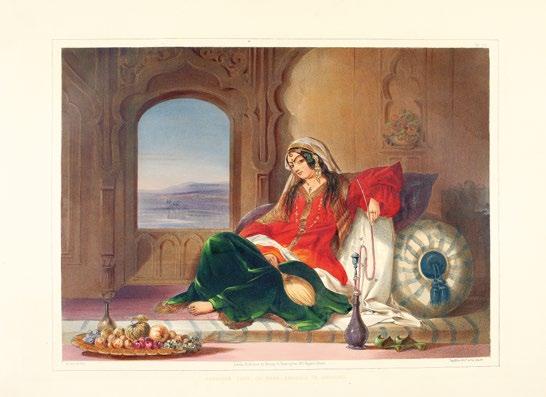

95 Shapero Rare Books
36. REPTON, Humphrey. Observations on the theory and practice of landscape gardening. Including some remarks on Grecian and Gothic architecture.
T. Bensley for J. Taylor, London, 1803.
an impOrtant wOrk which prOvides “a guide tO [reptOn’s] apprOach tO landscape design, with explanatiOns Of his aims and his methOds Of achieving them in specific instances”.
The book is a compilation of texts from a number of the Red Books he had composed since his last publication, many of them now lost - those for Balstrode, Corsham, Gayhurst, Shardeloes, and West Wycombe. Several are now in American collectionsthose for Armley, Brandesbury, Culford, Ferney, the Royal Fort, Bristol, and Stonelands.
Repton’s Red Books, almost always bound in red morocco, included Repton’s suggestions for ways to make clients’ estates even more beautiful; with a hill removed here, a lake created there, a clump of trees artfully placed... The books were not printed but were manuscripts with the texts, maps, and drawings done by experts at the height of their professions. Each book included a before and after - a watercolour view of the chosen scene after proposed changes had been made, overlaid by a hinged cutout turning the picture back to the original view.
The Red Books formed handsome albums of views for display in the patron’s library, to serve as plans or to record work in progress. But Repton’s work was very expensive: some clients commissioned their surveys for social prestige, but never attempted to put his recommendations into practice.
Repton’s Observations is, in effect, a handbook of tricks of the trade, or rather profession, for, unlike Capability Brown, who had usually contracted himself for work, Repton acted only as a consultant and overseer” (Millard). “The overlays in Repton’s books on landscape gardening, by means of which he showed selected prospects before and after he had turned his hand to them, have caused collectors to treasure his engravings as curiosities, but they are remarkable as well for the evidence of his draughtsmanship”(Ray).
Provenance: Granville Leveson-Gower, 1st Marquis of Stafford (1721-1803, binding); Louise Ward Watkins (1890-1974, bookplate).
First edition. 4to, stipple-engraved portrait frontispiece, 25 aquatint plates and 2 line-engraved plates, of which 12 are hand-coloured or tinted and 12 plates have overlays, 10 aquatint head and tail pieces and numerous woodcut illustrations in text, 2 of the vignettes with overlays, folding plate with short repairs,, Contemporary light brown calf gilt by Charles Hering (with his ticket on the front free endpaper), covers with gilt-ruled and blind-tooled border with centrally-placed gilt armorial of the arms of the LeversonGower family, surmounted by a Marquesses coronet, with the arms and coronet of an Earl in pretence, gilt turn-ins, marbled endpapers, marbled edges, neatly rebacked to style. Millard, British Books, 65 (second edition); Abbey Scenery 390; Berlin Kat. 3431; Ray 38.
£9,500 [ref: 92942]
96 Shapero Rare Books
Red BOOK TexTS


97 Shapero Rare Books
RepTON, Humphry. Sketches and hints on landscape gardening collected from designs and observations now in the posession of the different noblemen and gentlemen, for whose use they were originally made the whole tending to establish fixed principles in the art of laying out ground.
W. Bulmer & Co. for J. & J. Boydell and G. Nicol, London, [1794].
Humphry Repton (1752-1818) was the main successor to Lancelot “Capability” Brown as an improver of grounds for the English gentry in the late eighteenth and early nineteenth century. He was particularly noted for his “Red Books”. These were produced for each individual client and were made up from a manuscript description of his proposed improvements bound with Repton’s own watercolour drawings of the grounds, with his proposed alterations displayed on an overlay. The present work is made up to a large degree of extracts from the Red Books of 57 houses which Repton had been called upon to “improve”. A list of these houses, their location and their owners is given in a valuable two-page list towards the front of this volume. The work is broken down into various chapters: “Concerning Buildings”, “Concerning Water”, “Concerning Approaches”, etc. In each chapter Repton selects the relevant section from each Red Book that is helpful to the point he is trying to make.
In addition to the specific ideas that he is trying to convey, Repton also enters the fray on behalf of Capability Brown. The theoreticians, Payne Knight and Uvedale Price, had both written disparagingly of Brown’s work and Repton here answers their arguments; a lengthy letter that Repton wrote to Price in July 1794 is quoted in full. The work ends with an intriguing list of sixteen “Sources of pleasure in Landscape Gardening” and William Wyndham’s letter to Repton in support of his theories: “Places are not to be laid out with a view to their appearance in a picture, but to their uses, and the enjoyment of them in real life, and their conformity to those purposes is that which constitutes their true beauty: with this view gravel walks, and neat mown lawns... are in perfect good taste, and infinitely more conformable to the principles which form the basis of our pleasure in these instances, than the docks and thistles, and litter and disorder, that may make a much better figure in a picture”.
The plates echo the watercolours with which Repton invariably illustrated the Red Books. He makes extensive use of movable flaps or “slides” - generally to explain the effect he is trying to create by showing the property before his improvements (with the flap down) and after (with the flaps lifted). The quality of the aquatints is exceptional, and the folding view of the Duke of Portland’s house Welbeck Abbey in Nottinghamshire is particularly interesting as it apparently shows Repton and his assistants at work on a survey of the estate.
Landscape folio, half-title, pp. xvi, 83, [4], 10 hand-coloured aquatints engravings (1 folding, 3 double-page), each with one or more overslips, and 6 aquatint plates printed in black with a single tint added (4 with one or more overslips), 2 wood-engraved illustrations, 1 wood-engraved tailpiece, bound without the half title. Contemporary green straight-grained morocco, covers bordered with triple gilt fillets, spine in six compartments with double raised bands, the bands flanked and highlighted with gilt fillets, lettered in the second compartment, later gilt monogram in the first, gilt turn-ins.
Abbey Scenery 388; Archer 280.1; Henrey III, 1269; RIBA III, 405; Tooley 400
£15,000 [ref: 92943]
98 Shapero Rare Books
fIRST edITION Of The fIRST Of RepTON’S ThRee gReaT WORKS ON laNdSC ape gaRdeNINg.
RepTON’S fIRST WORK 37.



99 Shapero Rare Books
38. REPTON, H[umphry]; John Adey Repton. Fragments on the theory and practice of landscape gardening, including some remarks on Grecian and Gothic architecture, collected from various manuscripts, in the possession of the different noblemen and gentlemen, for use they were originally written; the whole tending to establish fixed principles in the respective arts.
J. Taylor, London, 1816.
the last Of reptOn’s celebrated wOrks
Written after the Prince of Wales had rejected Repton’s plans for the Royal Pavilion, Fragments was dedicated to the Prince Regent but the book makes no mention of any commission for the prince, rather it serves as a reproach to his manners and morals. Fragments focuses on a number of aristocratic landscapes: Cobham, Woburn, Endsleigh, Ashridge, Longleat, and on small commissions such as Ealing Park and White Lodge, which took in views of royal parks. They commemorate a historically minded, public spirited nobility. Other Fragments on commissions for a range of clients, from Norfolk squires to Essex merchants, establish a polite consensus around highly detailed plans for gardens. The final Fragment on Hare Street incorprates the outlook of “venerable noblemen” such as the Duke of Portland and Viscount Torrington in the view from Repton’s own garden:
“To demonstrate the little consequence of quantity or value, when speaking of beauty of scenery, many places have been mentioned, which may perhaps appear too inconsiderable in a work that treats of dukedoms and royal domains: but I wish to evince, that in many cases great effect may be produced by a very contracted quantity of land … nothing more is necessary than a terrace, or a few shrubs and flowers to form a frame to the picture.” (Fragment XXXVI. Harestreet. Of Quantity and Appropriation)
Provenance: Earl of Caledon (19th-century armorial bookplate).
First edition. Large 4to., xii, 238 pp., 42 aquatint plates and plans including 21 hand-coloured (3 folding) and 3 tinted, one woodcut, numerous vignettes throughout, 13 plates and 2 vignettes with overlays, bound without half-title. Contemporary blue straight-grained morocco gilt, covers panelled in blind, expertly rebacked to style with the spine in six compartments with double raised bands, the bands highlighted by gilt tooling, lettered in gilt in the second compartment, the others with elaborate repeat decoration in gilt and blind, gilt turn-ins, top edge gilt.
Abbey Scenery 391.
£16,500 [ref: 92941]
100 Shapero Rare Books

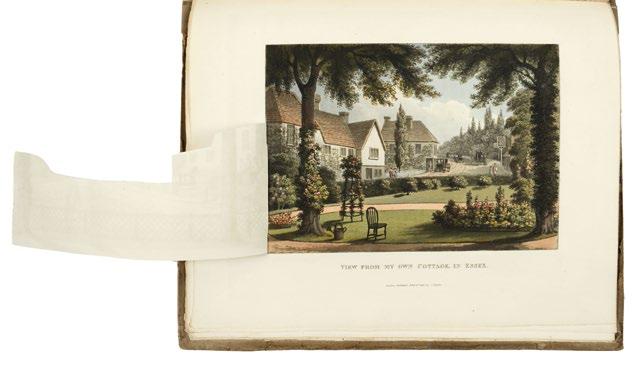
101 Shapero Rare Books
39. RICHARDSON,William (artist) and Edward CHURTON. Monastic ruins of Yorkshire. Robert Suter, York, 1843.

the rare, deluxe issue with the lithOgraphs hand-cOlOured, prOviding the finest depictiOns Of the great abbeys dissOlved by henry viii including riveaulx and fOuntains
The ruins are shown against the beautiful landscapes of Yorkshire, often featuring anglers, walkers, and sightseers, making the work lively despite its dry title.
An excellent copy of this magnificent work - Yorkshire’s answer to Roberts’ Holy Land, which it particularly resembles in this superior issue by the use of full-page hand-coloured plates on card. The lithographs were produced by Day & Son who also produced the illustrations for David Roberts. William Richardson (flourished circa 1840, died 1877), was the leading Yorkshire topographical artist of his time.
First edition. 2 volumes, large folio (61.5 x 46 cm ), hand-coloured map, lithographed dedication leaf with arms in colours and gold, 84 lithographed plates comprising: 57 full-page lithographed plates (of which 35 fully hand-coloured and mostly mounted on card); 26 half-page fully coloured views above the text (some mounted), with an elaborate initial printed in two or more colours, spotting mainly affecting some text leaves, contemporary dark morocco over thick boards, sides with borders in gilt and blind, gilt centrepieces, spines gilt, all edges gilt, extremities slightly rubbed.
Abbey Scenery 381.
£7,500 [ref: 91920]
102 Shapero Rare Books
deluxe ISSue WITh plaTeS COlOuRed ON C aRd
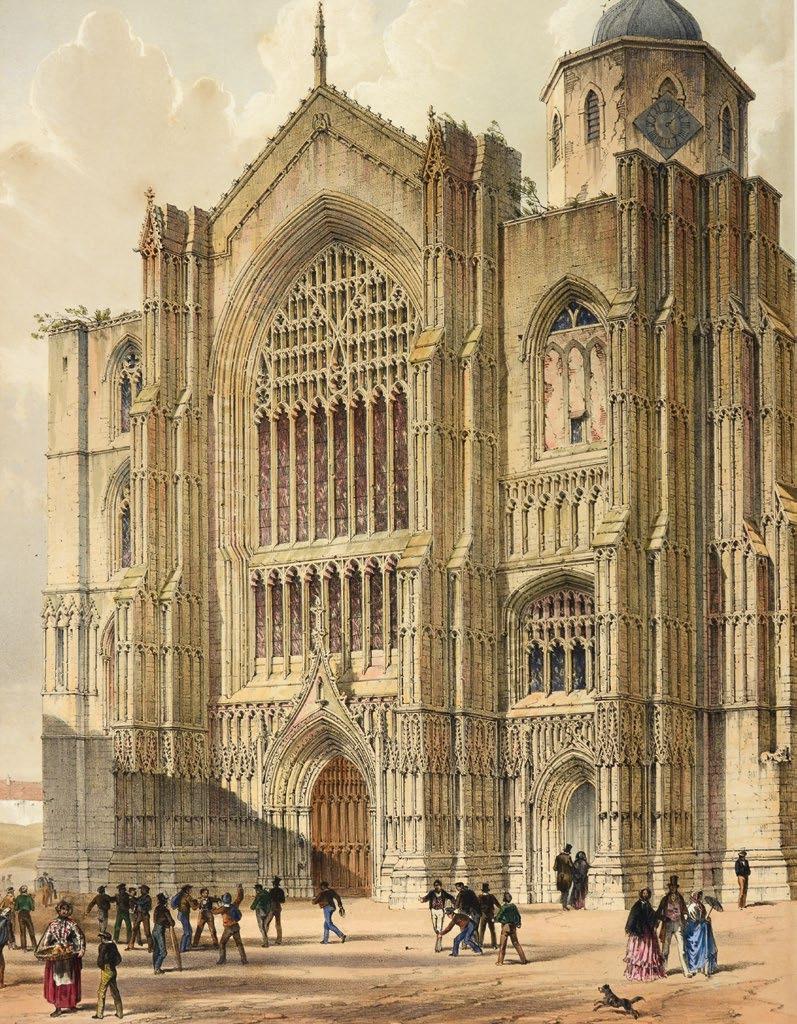
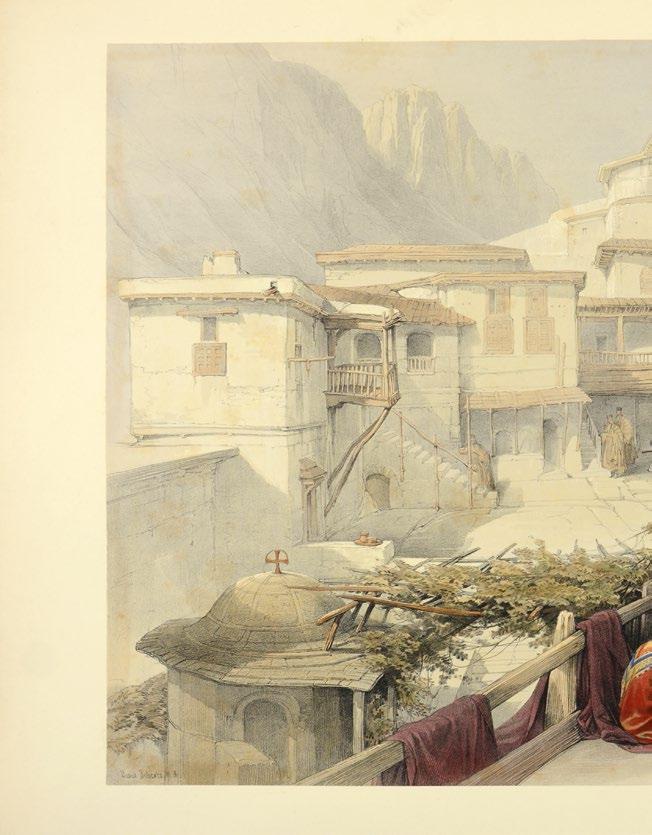
item 40 - ROBERTS. The Holy Land.

40. ROBERTS, David. The Holy Land, Syria, Idumea, Arabia, Egypt & Nubia... with historical descriptions by the Revd. George Croly.
F. G. Moon, London, 1842-1845.
a handsOme example in the preferred deluxe fOrmat Of One Of the mOst impOrtant and elabOrate ventures Of nineteenth-century publishing, and the apOtheOsis Of the tinted lithOgraph. nO publicatiOn befOre this had presented sO cOmprehensive a series Of views Of the mOnuments, landscape, and peOple Of the near east
In the 1830s tourism in the Holy Land was increasing as the Pasha of Egypt, Muhammad Ali, consolidated his authority and promoted the research into and adoption of European culture. Travel books describing and illustrating the holy sites proliferated, and the scientific investigations of Edward Robinson were published in 1841. David Roberts (1796–1864), a scene-painter for the Pantheon Theatre in Edinburgh, who had established a reputation as a painter of topographical and architectural views, took advantage of the trend to organize a painting expedition to the Holy Land in 1838.
Arriving in Cairo in September 1838, he crossed the desert by way of Suez, Mount Sinai, and Petra, to Gaza and Jerusalem accompanied by tribes of Bedouins, friends and guides. He later visited the Dead Sea, the Lake of Tiberias, Lebanon, and the ruins of Baalbac.
Returning to England in late 1839, he sought a publisher willing to produce a lavish edition of his views. Rejected by the Finden Brothers and by John Murray, he signed a contract with Francis Graham Moon in 1840. He and Moon shrewdly promoted their project by organizing a private viewing of Roberts’ watercolors and drawings for Queen Victoria, the Archbishop of Canterbury and other influential people who immediately subscribed. They mounted public exhibition of some travel sketches in many British cities, and the favourable press notices attracted additional subscriptions, amounting to nearly double what the project required.
His work brought tremendous fame, and historians praised the accuracy of his rendering of architectural details and sculptures.
First edition. 3 volumes, large folio. deluxe subscribers’ cOpy, portrait frontispiece, 3 pictorial lithograph titles and 120 plates lithographed by Louis Haghe after Roberts (60 full-page, 60 half-page), in the scarcest form, with original hand-colour, cut to the edge of the image and mounted on card in imitation of water-colours, as issued, mounted on guards throughout, map at end, scattered light spotting to a few plates, generally a clean fresh set, modern red half morocco gilt by Aquarius, marbled sides, an excellent copy. Abbey Travel 385; cf. Blackmer 1432.
£85,000 [ref: 91335]
106 Shapero Rare Books

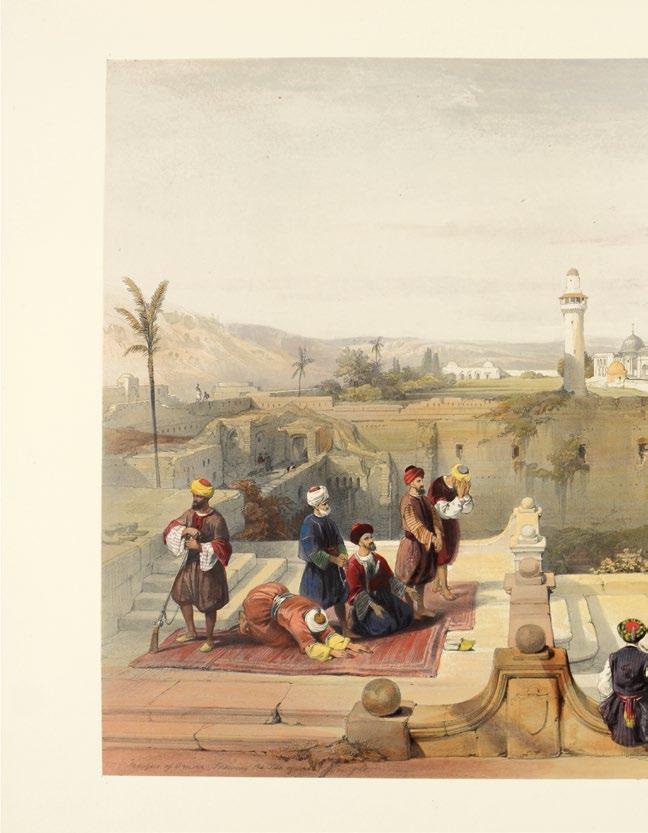
item 40 - ROBERTS. The Holy Land.

41. ROCQUE, John. An exact survey of the cities of London and Westminster, the borough of Southwark, with the country near ten miles round; begun in 1741, finished in 1745... Engrav’d by Richard Parr, and printed by W. Pratt.
J. Rocque, London, 1746 [but 1747].
an excellent example Of rOcque’s superb map Of greater lOndOn
The map extends out to Hampton Court in the south-west; Marylebone in the northwest; Woodford in the north-east; and the Victualling office warehouse on the Thames to the south-east.
John Rocque was a surveyor and a French Huguenot, who emigrated with the rest of his family to London in the 1730s. Initially he surveyed wealthy gentleman’s estates, and also produced wonderful plans of Kensington Gardens, and Hampton Court. He then set about producing an important series of large scale maps of London. Rocque’s maps also served as a basis for a number of others produced by publishers both in this country and abroad. His plans are supreme in terms of accuracy, decorative merit and scale.
The present map was issued to complement Rocque’s 24 sheet map of central London published in 1746.
Folio (51.6 x 37.3cm), very large engraved plan within engraved ornamental border on 16 double-page sheets, title in English, Latin and French, printed in red and black, emblematic group in cartouche at upper border surmounted by arms of the City of London, leaf with subscribers’ list and index of towns and villages to verso. (Without the dedication to Lord Burlington, a few very minor marginal nicks and tears to a couple of sheets, light variable browning and offsetting), modern half burgundy morocco over old marbled boards, morocco lettering piece to upper cover, an excellent example. Glanville 28; Howgego 94 (2).
£15,000 [ref: 92248]
110 Shapero Rare Books
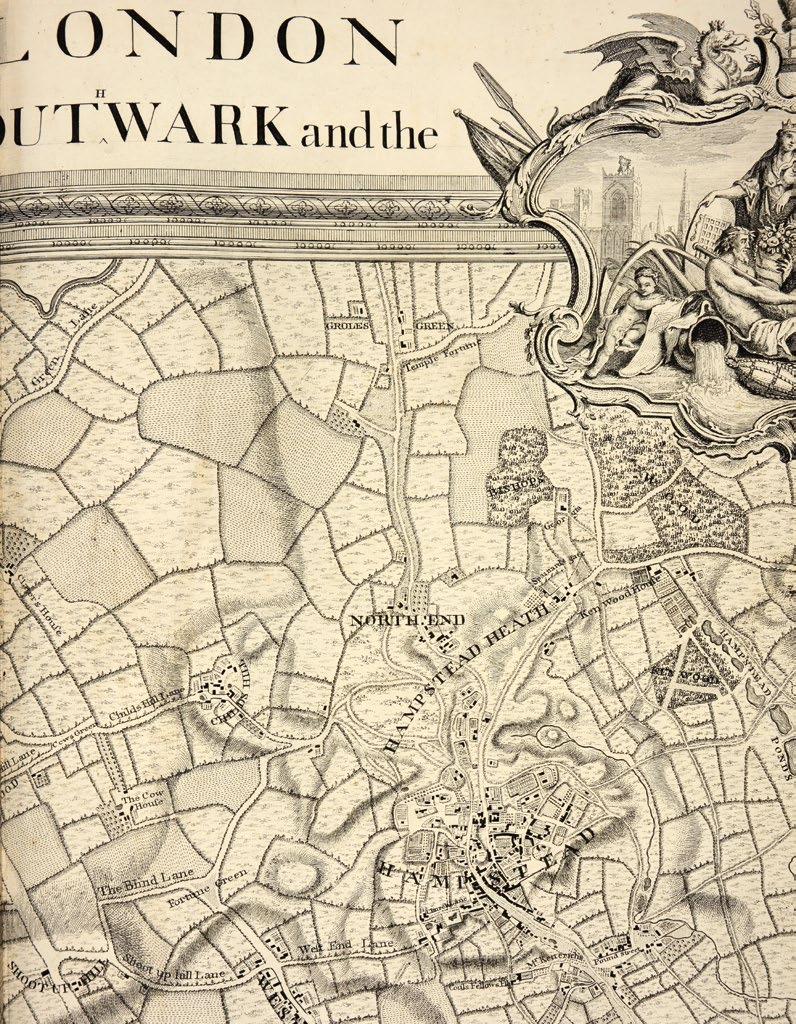
42. SAINT-NON, L’Abbe Richard de. Voyage Pittoresque ou description des Royaumes de Naples et de Sicile [...] contenant un precis historique de leurs revolutions. Les cartes, plans & vues du royaume & de la ville de Naples. Ses palais, ses eglises, ses tombeaux. Ses poetes, peintres & musiciens celebres. Le Vesuve, avec l’histoire de ses eEruptions les plus connues. Les moeurs & usages du peuple Napolitain, ainsi qu’une idee de son gouvernement, du commerce & des productions naturelles de ce pays. Clousier, Paris 1781-86.

The gReaT vOyage pITTOReSQue Of SOuTheRN ITaly, BOuNd IN full Red mOROCCO
Saint-Non originally travelled to Italy in 1759 with Fragonard and Robert. He produced a series of collections of engravings as a result and, encouraged by the success of these, in 1777 he planned the far more ambitious “Voyage Pittoresque”, an account of his travels in Southern Italy. Although he already had much material, it needed to be supplemented with more contemporary accounts and illustrations of the eruption of Vesuvius etc. An expedition was sent through Naples and Sicily under Denon whilst Saint-Non remained in France to supervise the production of the prints and to organize the material for publication.
The work was arranged in narrative style freely borrowing from D’Hancarville, Hamilton and others for additional material. Some of the most important illustrators of the time were used including Cochin and Saint-Aubin. Throughout the work SaintNon strove to maintain the interest of his subscribers by making the work entertaining, often including popular spectacles at the expense of more worthy historical material.
“The completed work is one of the most beautiful that a private person has ever produced, and it is unparalled among the sumptuous voyages pittoresques publications. The ambitious undertaking became the model for later voyages pittoresques.” (Millard).
First edition. 4 volumes bound in 5, large folio (52 x 35 cm approx.), 5 title vignettes, engraved dedication to the Queen, 379 engraved plates (including 7 maps), some showing 2 subjects, 4 additional maps and plans, 15 head- and 96 tail-pieces, without the Phallus plate in vol ii (not always present), and the 14 engraved plates of medals known as planches doubles de medailles in vol iv (not always present) occasional browning, contemporary red morocco gilt covers with gilt borders, spines in eight compartments, gilt lettered direct in second and fifth, raised bands ruled in gilt, small repairs to extremities, a very attractive set. Brunet V, 55; Millard, French Books 148; Cohen de Ricci 928.
£30,000 [ref: 91880]
112 Shapero Rare Books

113 Shapero Rare Books

item 43 - Salt’s Views. The Governor of Bengal’s copy.

43. SALT, Henry. Twenty four views taken in St. Helena, the Cape, India, Ceylon, Abyssinia & Egypt.
William Miller,
London, 1809.
a RemaRKaBle COpy Of ThIS magNIfICeNT BOOK Examples are seldom found with early watermarks. The colouring in these early copies is distinctly superior, a more muted and subtle palette being employed.
One of the most attractive of all colour-plate books, intended by its publisher to be a continuation of the Daniells’ Oriental Scenery, being uniform in size, style, and execution.
George Annesley, Viscount Valentia, left England in June 1802 on the Minerva, for a Grand Tour of the East with Henry Salt. They were antiquarians and avid collectors. Salt had earlier finished his training with the topographical draughtsman and diarist, Joseph Farrington, and Valentia appointed him to be his official artist and secretary for the tour. The plates include fine views of Chowringhee; the fort of Jaunpur; 2 aquatints of Lucknow including the mosque in the Great Imambara; the great Temple at Tanjore; Poona; the Chaitya Cave; 2 fine aquatints of Cairo; Cape Town, etc. Valentia and Salt returned to England in 1806. Salt eventually became British Consul-General in Egypt, where he died aged 47.
Provenance: H. E. The Governor of Bengal (bookplate).
First edition. Landscape folio (80 x 57 cm.), pictorial aquatint title, 24 fine hand-coloured aquatint plates, engraved by D. Havell after Henry Salt, all without the slightest foxing, early watermarks all pre-publication, on Whatman paper ranging from 1794 to 1806. Originally bound in portrait format now re- arranged in landscape, rebacked and edged in leather retaining the original marbled boards, with a new morocco label. Abbey, Travel, 515; Tooley 440.
£45,000 [ref: 92098]

116 Shapero Rare Books
SupeRB example


117 Shapero Rare Books
44. SELIGMANN, Johann Michael. Verzameling van Uitlandscheen Zeldzaame Vogelen . Jan Christiaan Sepp, Amsterdam, 1772-1781.
A fine copy of the Dutch translation of Georg Leonhard Huth’s German edition of George Edwards A Natural History of Uncommon Birds and Gleanings of Natural History with Mark Catesby’s Natural History of Carolina, Florida and the Bahama Islands Seligmann re-engraved the Catesby and Edwards plates for the German edition of 1749-76, often adding highly attractive floral and scenic backgrounds. The plates include 425 birds, the remaining being of monkeys, elephants, zebras and other animals.
a rare wOrk, the subscribers list recOrds just ninety cOpies
5 volumes, folio, 473 hand-coloured engraved plates by Seligmann and Johann Leitner after George Edwards and Mark Catesby, contemporary tree calf gilt, neat repairs to extremities, a fine set. Nissen BBI 859; Zimmer 200; Fine Bird Books 73; Landwehr, Dutch books, 180.
£40,000 [ref: 91888]
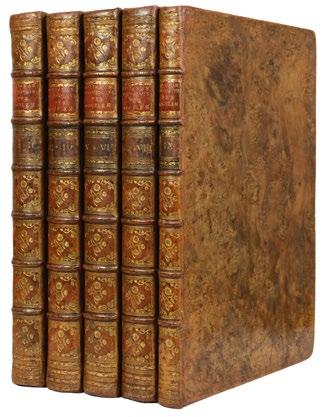
118 Shapero Rare Books




119 Shapero Rare Books
45. SWEERT, Emanuel. Florilegium amplissimum et selectissimum, quo non tantum varia diversorum florum praestantissimorum et numquam antea exhibitorum genera, sed et rarae quamplurimae Indcarum plantarum et radicum formaie ad vivum partibus duabus, quator etiam linguis afferuntur et delineantur. Jannson, Amsterdam, 1620-1614.
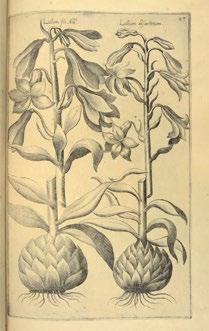

Emanuel Sweert (1552–1612) was a Dutch painter and nurseryman noted for his publication in 1612 at Frankfurt-am-Main of the present work.
Sweert was born at Zevenbergen and lived in a period when new plants from across the world were being introduced to Europe via Dutch, English and French ships. To meet the burgeoning interest in plants by the public, nurseries were being established by wealthy merchants in order to meet the demand. Botanical illustration suddenly found a new outlet in the production of nursery catalogues. Sweert prepared his Florilegium as a guide of his available stock for the Frankfurt Fair of 1612. The plates, depicting some 560 bulbs and flowers, were from the Johann Theodore de Bry Florilegium which in turn was based on that by Pierre Vallet. His attractively depicted bulbs sparked their popularity, leading to 6 editions of the work between 1612 and 1647, and a demand which would later result in “Tulipomania”. At the time of the fair Sweert was in the employ of Emperor Rudolf II as head of his gardens in Vienna. He borrowed freely from plates that had been published before, so that many of those that appeared in the Florilegium had been cultivated in the gardens of King Henry IV of France at the Louvre. He died in Amsterdam.
Two parts in a folio volume (41.5 x 27 cm), engraved pictorial title (neat paper restoration to blank foremargin and lower edge) dated 1620, printed title to second part dated 1614, 17 leaves of text, engraved portrait, 100 copper-engaved plates (plate 11 with fore-margin repaired), general light toning, old calf, rebacked preserving spine, red morocco lettering piece, lacks front free endpapers. Nissen BB1 1912; Cf. Hunt 196 (first edition, with a final blank leaf at end of part 1, not present here).
£8,500 [ref: 91561]
120 Shapero Rare Books

121 Shapero Rare Books

item 46 - The Szyk Haggadah.
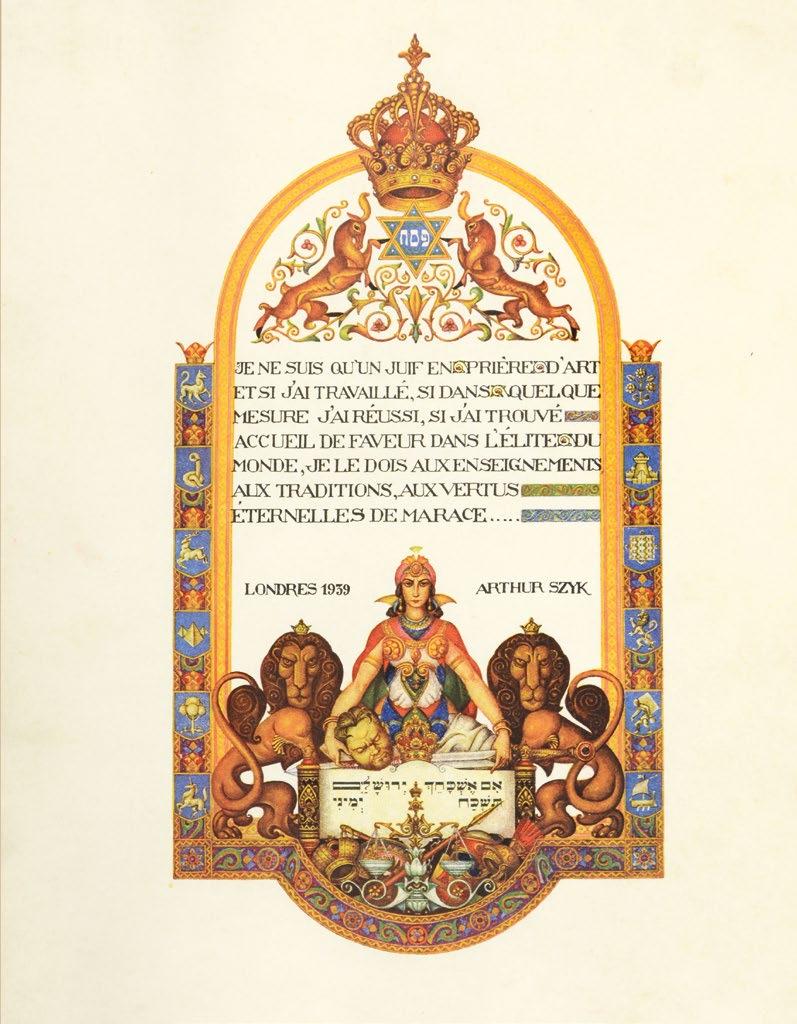
lImITed edITION pRINTed ON vellum, magNIfICeNTly BOuNd, SzyK’S OWN COpy.
Arthur Szyk, a Polish Jew, produced works characterised in their material content by social and political commitment, and in their formal aspect by the rejection of modernism and drawing on the traditions of medieval and renaissance painting, especially illuminated manuscripts from those periods. Unlike most caricaturists, Szyk always showed great attention to the colour effects and details in his works.
Szyk’s drawings and paintings became even more politically engaged when Hitler took power in Germany in 1933. Szyk started drawing Führer’s caricatures as early as 1933; probably, the first work of the artist directed against the leader of the Third Reich was a drawing of Hitler, made in pencil, in which he was shown as a new pharaoh. These drawings anticipated the present great series of Szyk’s art – the Haggadah, his magnum opus. Szyk illustrated it in 48 drawings in the years 1932-1938, and the development of the political situation in Germany at that time made him introduce some contemporary elements to it. These referred to, in particular, the parable of the four sons, in which the “wicked son” was portrayed as a man wearing German clothes, with a Hitler-like moustache. The expression of the series was even stronger in its original version: the drawings showed snakes with swastikas, there were also heads of Hermann Göring and Joseph Goebbels.
In 1937, Arthur Szyk went to London to supervise the publication of Haggadah However, the artist had to agree to many compromises during the work which lasted three years, including painting over of all swastikas. It is not clear whether he did it as a result of the pressure by his publisher or the British politicians, who pursued the policy of appeasement in relation to Germany. Finally, Haggadah was published in London in 1940; the artist dedicated it to King George VI. The work was widely acclaimed by critics; according to The Times, it was “wOrthy tO be placed amOng the mOst beautiful Of bOOks that the hand Of man has ever prOduced”.
Provenance: Arthur Szyk, passed by direct family descent to the previous owner.

Large 4to (28 x 23.7 cm). Text in Hebrew and English, printed On vellum in variously coloured inks, 14 fullpage and numerous smaller colour halftone reproductions of Szyk’s drawings including decorative initials, vignettes and border decorations. Original blue crushed morocco by Sangorski and Sutcliffe, covers tooled with image of a Hebrew prophet after Szyk, spine gilt in compartments, gilt lettered in two, turn-ins gilt, silk doublures printed with a monochromatic illustration of Moses supporting the Ten Commandments, kept in original dark blue half morocco folding case. Fine.
£30,000 [ref: 92250]
124 Shapero Rare Books
46. SZYK, Arthur (illustrator). The Haggadah. Edited by Cecil Roth. Beaconsfield Press, London, 1939.
The aRTIST’S OWN COpy Of hIS CeleBRaTed haggadah

125 Shapero Rare Books
veRy SCaRCe. ONe Of The RaReST vIeW BOOKS ON INdIa, aNd aN INCuNaBle Of aQuaTINT; although this work is contemporary with that of Hodges (1785-88; see item 18 above) and Thomas Daniell ( Views of Calcutta,1786-88), its existence is little known and it is not recorded by Prideaux.
Elisha Trapaud (c.1750-1828), probably of Huguenot origin, joined the Madras Engineers as Ensign in 1779. Trapaud announced his intention to publish views of different parts of India through which he had passed, in the Calcutta Gazette for April 1786. The aquatints include studies of Fort St. George in Madras, buildings at Madura, Tanjore, and Srirangam, beside the rock-fort at Trichinopoly.
Provenance: Westdean Library (home of surrealist writer Edward James), book label. Armorial bookplate staing that this book book was given in memory of John Duthoit, RIBA, (1873-1944).
First edition. Large folio (54 x 43cm. approx.), 20 sepia aquatint plates by J. Wells after drawings by the author, captioned underneath image, imprint “published as the act directs, 1788,” no title page issued for the work, modern calf over old boards, an excellent copy. Abbey Travel 417.
£40,000 [ref: 90704]

126 Shapero Rare Books
47. TRAPAUD, Captain Elisha. [Twenty views of India] [Stockdale, London], 1788.

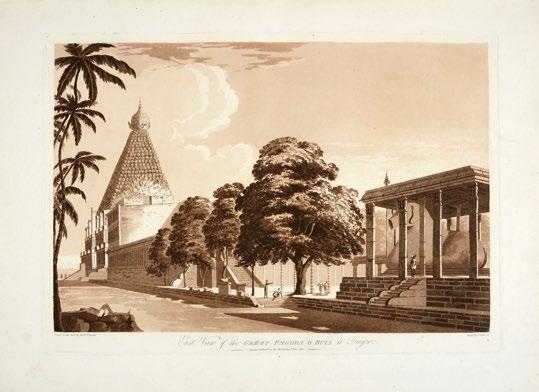
127 Shapero Rare Books
48. TURNER, J. M. W. Liber Studiorum. 1812 [plates watermarked 1807-1810].
a very gOOd cOmplete set Of turner’s famed Liber StudiOrum, with all plates On uncut sheets.
Turner’s Liber Studiorum, issued in a series of 14 parts of 5 plates per part, was published intermittently over the course of more than a decade. Turner began with the intention to produce the etched foundation of each plate himself and to leave the mezzotint to others, however, he experimented himself and eight of the plates were finished by Turner himself. For the remaining plates, Turner intended originally to use the engraver Charles Turner, but the painter’s exacting demands and the disputes they led to made it necessary to use many others. Seventy-one plates were published eventually of a proposed one hundred, with a further twenty printed but never published; the published plates are categorised as architectural, pastoral, marine, historical and mountains with the corresponding initial printed above each. Turner’s title for the series, the Liber Studiorum, is a direct reference to the Liber Veritatis of Claude Lorrain.
In the present, complete, copy, the states (as per Finberg) are as follows: 7 plates in first state, 22 plates in second state, 25 plates in third state, 12 plates in fourth state, 5 plates in fifth state and no plates in sixth or later states. Full details of the state of each plate and their order is available on request.
‘Were all Turner’s paintings and drawings destroyed, his Liber Studiorum would suffice to establish his reputation as one of the great artists of Europe... the work contains some of the freshest and most vigorous outpourings of Turner’s genius...Liber Studiorum is the work of a young man. Artists sometimes like poets do their best work when they are young. It may be that Turner’s Liber Studiorum contains the pith of all that is best in his life and work.’ (Finberg).
‘... a truly monumental work, taking rank with the highest production of Turner’s genius, and exhibiting intimately his strength, as indeed also his weakness, during a period of his life in which a large part of his strongest and soberest... work was done... ‘. (Rawlinson).
Two volumes folio. (36.4 x 52 cm). Each volume with sheet of thick card with elaborate manuscript title, vol. number and list of plates in black ink and 71 etched mezzotint and aquatint plates (vol. I with plates numbered 1 - 35, vol. II with 36 - 71) printed in warm sanguine or sepia ink on uncut sheets of laid or wove paper as applicable with stab marks at left and retaining deckle edges, each plate mounted to sheet of card with passepartout, pencil numeration to passepartouts at lower right. Plates by J. M. W. Turner (10 plates), I. C. Easling (4), C. Turner (23), W. Say (11), R. Dunkarton (5), Thos. Lupton (4), S. W. Reynolds (2), F. C. Lewis (1), W. Annis (1), H. Dawe (4), Th. Hodgetts (3), Annis and Easling (1) and G. Clint (2) after J. M. W. Turner. One plate with several old repairs, occasional foxing or soiling; several plates with pencil annotations recto or verso in various hands. Various sheet sizes: c.300 x 440 mm; mount size: 344 x 508 mm. Contemporary green morocco portfolios by Agnew & Sons with their partial label to front pastedown of vol. I, front boards with rules in gilt and blind with floral corner tools, titles gilt to spines, cream glazed board lining and flaps, turn-ins ruled in gilt, green silk ties. Finberg 1 - 71; see also Rawlinson, Turner’s Liber Studiorum, London 1878.
£32,500 [ref: 92481]
128 Shapero Rare Books

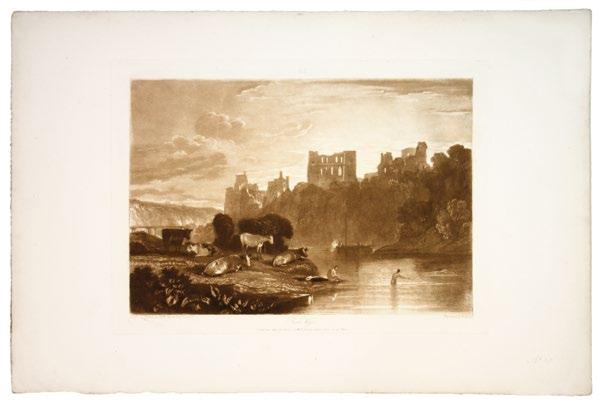
129 Shapero Rare Books
49. VIDAL, Emeric Essex. Picturesque illustrations of Buenos Ayres and Monte Video; consisting of twenty-four views, accompanied with descriptions of the scenery, and of the costumes, manners, &c. of the inhabitants of those cities and their environs. R. Ackermann, London, 1820.
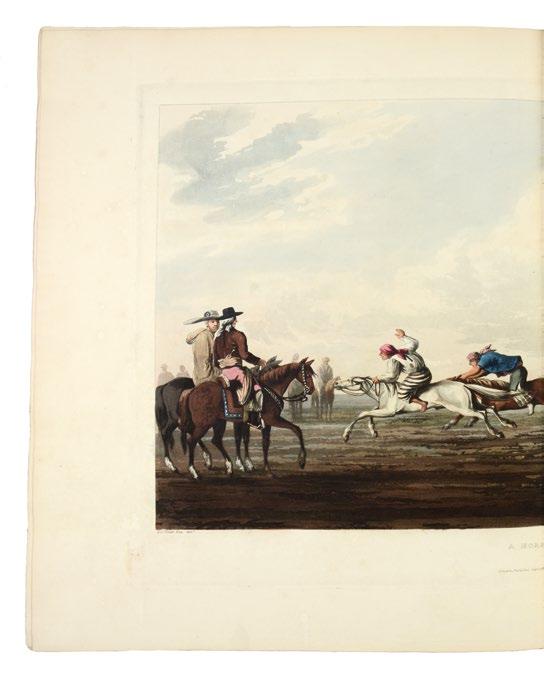
the finest pictOrial recOrd Of buenOs aires up tO that time, depicting the transfOrmatiOn Of buenOs aires tO a new wOrld metrOpOlis. One Of 50 large paper cOpies.
Vidal (1791-1861), born in Brentford, Middlesex to a family of Basque origin, joined the Royal Navy when he was 15. While staying in Rio de la Plata from 1816 to 1818, during the expulsion of the Spanish Viceroy and the period of civil wars, produced
130 Shapero Rare Books
fINe vIeWS Of BueNOS aIReS IN laRge papeR
watercolours depicting the regions surrounding Montevideo and Buenos Aires. The illustrations record numerous views of Buenos Aires, its port and neighbouring villages, and its inhabitants: travelling salesmen, gauchos, soldiers and scenes of peasant customs.
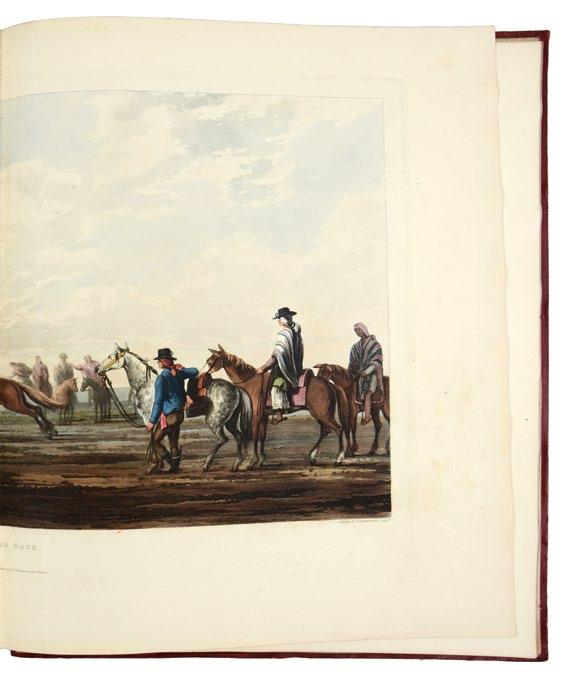
Provenance: Norman Bobins (bookplate).
First edition. 4tO , 24 hand coloured aquatints (4 folding), original red rcloth gilt, neatly rebacked preserving spine, an excellent example. Sabin 99460; Abbey 698; Tooley 495.
£13,500 [ref: 92946]
131 Shapero Rare Books
classic cOllectiOn Of thames views.
Westall was a historical painter from a Norwich family, and is considered at his best in watercolour. The tour is presented in three sections: the first from the river’s source to Oxford; the second from Oxford to London; and the third from London to where it joins the English Channel. Interestingly, at the time, it was felt necessary to offer some justification for the work appearing at all: the vogue when the present work was published was for picturesque scenery of the wilder and more exotic kind. The author in the preface admits that whilst the Thames does not qualify as either wild or exotic, its banks do “display all the softer graces and all the attractive loveliness of Nature in her sweetest mood, heightened by the taste, skill, and ingenuity of man; - they are decorated by venerable monuments of antiquity, and by prodigies of modern art.”

First edition, early issue with pre-publication watermarks. 4to., folding map, 24 fine full-page hand coloured plates and 2 hand coloured vignettes; usual light offsetting to plates, contemporary diced Russia, covers elaborately panelled in gilt and blind with fillets with neo-classical and neo-gothic decoration, the spine in five compartments with broad semi-raised bands, the bands highlighted with gilt tooling and flanked with gilt fillets and a roll tool in blind, lettered in the second compartment, elaborate repeat decoration in gilt to the others, gilt turn-ins, green endpapers, gilt edges. A fine copy. Abbey Scenery, 435; Adams, London Illustrated 157; Tooley p265.
£4,500 [ref: 92945]
132 Shapero Rare Books
50. WESTALL, William; Samuel Owen. Picturesque tour of the River Thames. R. Ackermann, London, 1828.
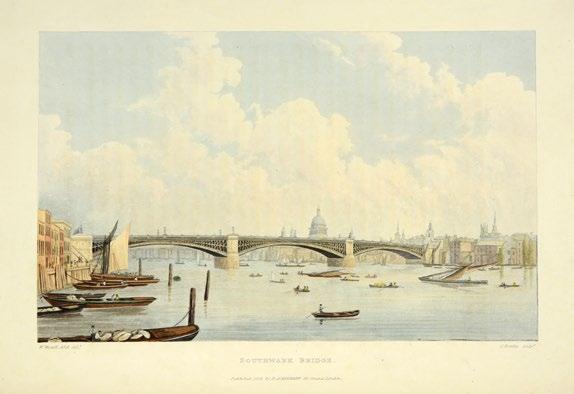

133 Shapero Rare Books
Shapero Rare Books
32 Saint George Street
London W1S 2EA
Tel: +44 207 493 0876
rarebooks@shapero.com
www.shapero.com
A member of the Scholium Group
TERMS AND CONDITIONS
The conditions of all books has been described; all items in this catalogue are guaranteed to be complete unless otherwise stated.
All prices are nett and do not include postage and packing.
Invoices will be rendered in £ sterling. The title of goods does not pass to the purchaser until the invoice is paid in full.
VAT Number G.B. 105 103 675
Front cover image - item 26 natteS Paris, and St Denis...
Frontispiece image - item 32 piraneSI. Opera Varie...
Inside front cover image - item 33 PIRANESI. Vedute di Roma.
Inside back cover image- item 27 OrlOwski The Kinnaird Sketchbook.
NB: The illustrations are not equally scaled. Exact dimensions will be provided on request.
Compiled by Julian MacKenzie
Design and Photography by Ivone Chao
Printed by LatimerTrend









































 item 13 - Daniell, Thomas and William. Oriental Scenery.
item 13 - Daniell, Thomas and William. Oriental Scenery.












































































































